Abstract
The Mensa Isiaca is a bronze table decorated with elaborate polychrome metal inlays of Egyptian-style figures and pseudo-hieroglyphs. First appearing in Rome in the 16th century, its manufacture, origin, and significance have been the subject of much inquiry and speculation. This study, conducted by conservators and scientists of the J. Paul Getty Museum and the Getty Conservation Institute, aims to improve our understanding of the materials and techniques used in its creation. Examination methods employed were non-invasive and non-destructive, including optical microscopy, X-ray fluorescence (XRF) spectroscopy, macro XRF (MA-XRF) scanning, and X-radiography. Results reveal the base and inlaid figures were created using a minimum of seven distinct alloys, including silver, black bronze, and multiple copper/zinc alloys. The data provided by the MA-XRF elemental maps offer the most accurate visualization of the imagery and pseudo-hieroglyphs to date, and also indicate relationships between the choice of alloys used for clothing and skin tones. Overall, the study improves our understanding of the casting process, methods of inlaying, changes to the surface due to aging and deterioration, as well as the nature of historic repairs and alterations. Using these new findings as a guide, a digital reconstruction of the original appearance is proposed. While many questions remain, these results provide a more complete picture of the Mensa Isiaca, which will afford scholars new tools for unraveling the significance of this piece and its context within the ancient world.
1. Introduction
Mensa Isiaca. 1st century BCE – 1st century CE. Bronze, inlays in other metal alloys. Side panels shown separately for clarity. Edge dimensions are in cm. Museo Egizio, Turin, Cat. 7155. Photos courtesy of Museo Egizio, annotated by the authors.
Prior to the deciphering of hieroglyphs by Jean-François Champollion in 1822,3 the Mensa’s depictions were often given mystical interpretations and ascribed an occult significance, and the array of different colored metal inlays was attributed to the results of alchemical experimentation.4 Although the Mensa’s hieroglyphs were eventually judged to be spurious, they may have been influenced by Greco-Roman papyri.5 While not the result of alchemy, the intricately detailed inlaid figures are a tour-de-force of metalwork: as will be discussed, different metals and metal alloys were employed to produce the wide variety of colored inlays found across the decorative scheme.
In 2018, the Mensa was showcased at the J. Paul Getty Museum as part of the exhibition “Beyond the Nile: Egypt and the Classical World”, which examined cross-cultural interactions and influences between Egypt and other parts of the ancient Mediterranean World.6 While at the Getty, a team of conservators and scientists took advantage of newly developed technologies to study the Mensa. Previous analyses of the Mensa’s metals by Alessandra Giumlia-Mair7
The Getty study aimed to improve our understanding of the materials and techniques used in the creation of the Mensa, and address specific questions relating to 1) how the Mensa was cast (including subsequent repairing and patching), 2) what materials were used for the different inlays, 3) how the inlays were set into the bronze base, 4) how the surface may have been finished, and 5) what the original appearance might have been. The research program was designed around non-invasive, non-destructive methods of examination and analysis. A thorough visual examination using optical microscopy aided in the visualization of fine details. Material analysis using X-ray fluorescence spectroscopy (XRF)8 provided detailed information about the elemental composition of the different metals and metal alloys. X-radiography supplied information about the overall structure. Details about the specific techniques employed can be found in the “Methods” section at the end of this paper.
2. The Mensa: Material and iconography in context
While the imagery on the Mensa was drawn from well-known ancient Egyptian iconography, most scholars agree it was created in Rome between the 1st century BCE and the 1st century CE.9 Although without any direct parallel, the Mensa was not created in isolation. Casting of large-scale bronzes was well established in Rome at that time, as were surface decoration techniques for metals. However, the combination of its size, technical virtuosity, and iconographic and ornamental vocabulary, creates a puzzle for archaeometallurgists and art historians alike.
2.1 Description and design
The Mensa is in remarkably good condition,10 although the design is difficult to read with the naked eye as some inlays, presumably once distinct in color, now appear similar to the background metal. The legibility of the inlays is further reduced due to the presence of tarnish and mottled red-to-brown copper corrosion products extending across the surface, creating indistinct, blurred boundaries. Because of the difficulty in discerning the Mensa’s
Drawing of the Mensa Isiaca taken from Lorenzo Pignoria and Giacomo Fillippo Tomasini, Laurentii Pignorii Patavini Mensa Isiaca, Amsterdam 1669, retouched by Piera Luisolo. Image courtesy of Museo Egizio.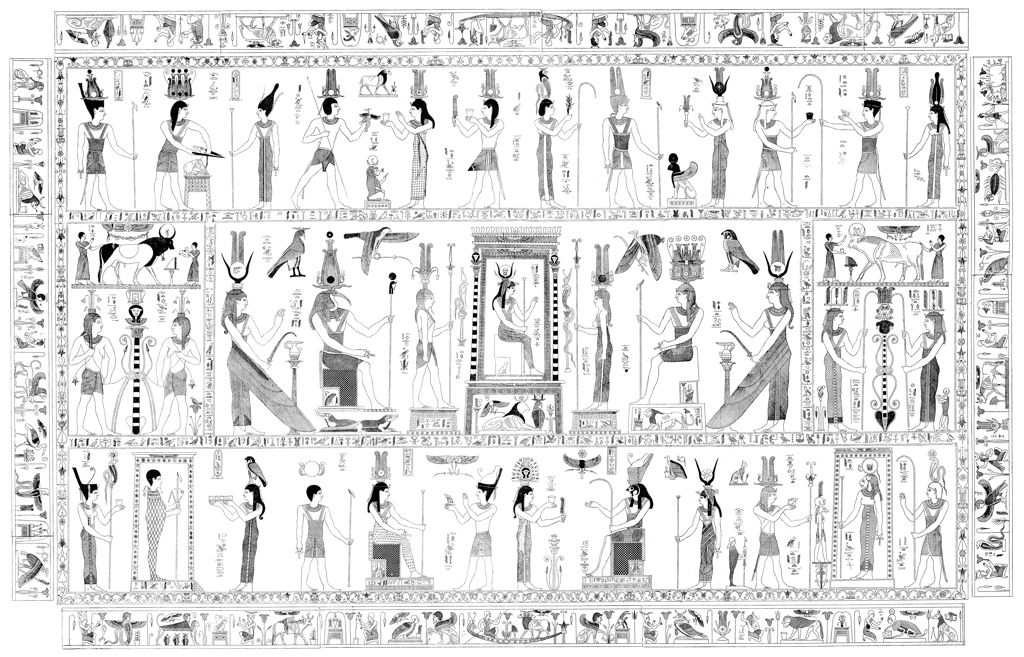
The Mensa’s surface is divided by rows and columns of pseudo-hieroglyphs into five framed sections organized in three horizontal registers (one section in the upper and lower registers and three in the middle) filled with depictions of deities, religious offerings, and other scenes emblematic of ancient Egypt.11 In a 1978 publication, Enrica Leospo designated the main sections with the letters A-E and assigned numbers to the main figures within each scene; for simplicity, we will use Leospo’s notation here when referring to scenes or figures (Fig. 3).12 The carefully laid out and symmetric arrangement of figures on the Mensa has been judged to be an elaboration on ancient Egyptian temple wall decorations, adapted for use as an altar for a Roman Temple of Isis. As such, the Mensa serves as a representation of the cultural transfer of the rites of Isis to Imperial Rome and has been described as “a visual translation of Greek hymns to Isis”.13
Enrica Leospo’s labeling scheme for the five main sections (A-E), with main figures numbered, and individual scenes (Tavola I – XI) across the Mensa. Photo of the Mensa Isiaca processed and annotated by the authors.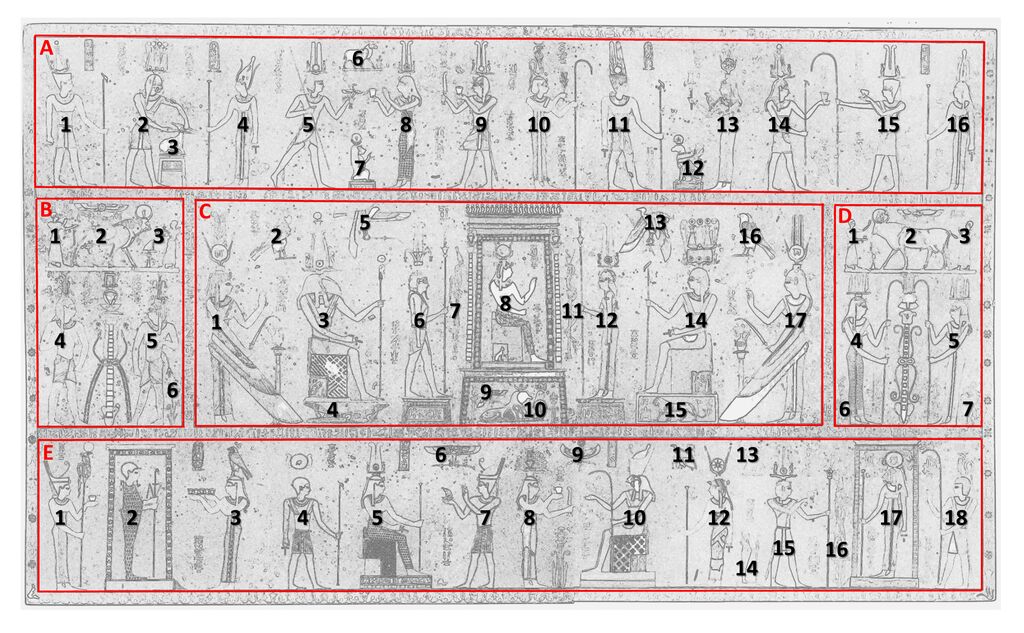
Due to its sophistication and singularity, some scholars have argued the Mensa is an invention of the Italian Renaissance, but those ideas have been disputed on the basis of the Mensa’s iconography and metallurgy, both of which were unknown in Italy during that time.14 In particular, the composition of the bronze base plate, discussed below, appears to fall outside the range of typical Renaissance bronze alloy compositions.15 Because its execution is without direct parallel in the Roman world, it has been suggested the design of the Mensa’s inlays may have been the work of someone with a particular knowledge of Egyptian priestly culture, although not of the hieroglyphic script.16 It has been further suggested that Egyptian recipes and traditions, some of which were published in ancient alchemists’ texts, were followed in the Mensa’s creation.17
2.2 Color and comparanda
During the period to which the Mensa is dated (1st century BCE – 1st century CE), Egyptianizing decorations, as well as references to Egyptian mythology, proliferated in the living quarters and luxury items of the elite in Rome and the Bay of Naples.18 For example, an elaborate inlaid Roman obsidian skyphos in the Museo Archeologico Nazionale di Napoli
Obsidian cup (skyphos). Roman, 1st century BCE – 1st century CE. Found in room 37, Villa San Marco, Stabiae. Obsidian inlaid with pink and white coral, carnelian, jasper, lapis lazuli, and malachite, set in gold. Museo Archeologico Nazionale di Napoli, inv. no 294473. Photo courtesy of Museo Archeologico Nazionale di Napoli.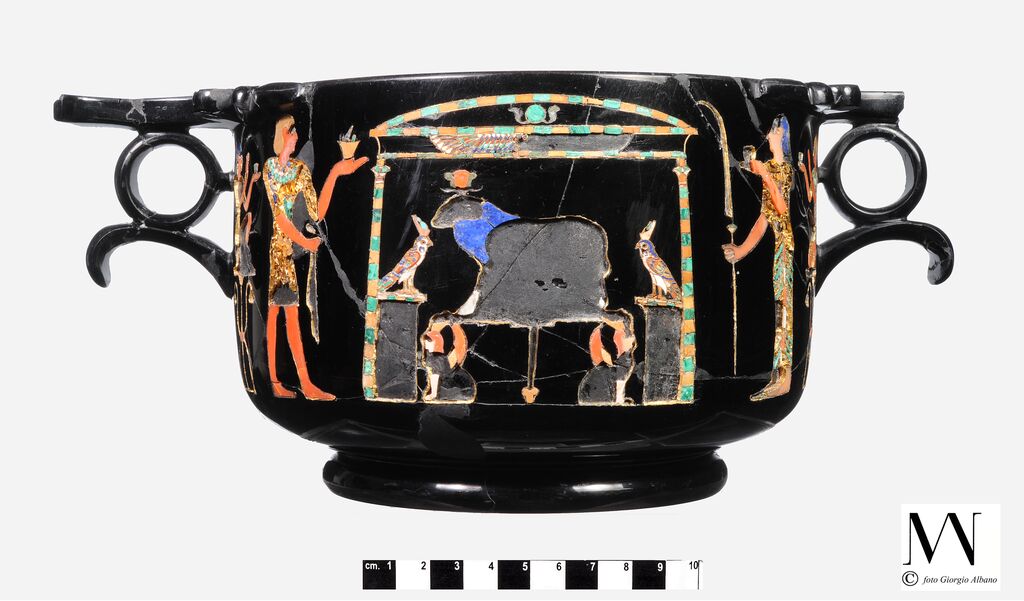
As in many cultures, color was an important part of Roman life. It was recognized as early as the 18th century that many now white marble sculptures were originally covered with a vivid and complex polychromy, and recent technical studies have provided additional insights into the materials and use of color in antiquity.20 In ancient Egypt, color was likewise ubiquitous, evidence of which is abundantly preserved on polychrome stone sculptures, painted architectural surfaces, and decorative and funerary arts, often adorned with inlays of semi-precious stones, ivory, ebony, colored glass, and Egyptian faience.21
Some materials and colors also had specific symbolic significance.22 Gold, for example, was associated with the divine and eternal life; the flesh of the gods was said to be of gold and their bones of silver. In the depiction of humans and deities, men’s skin typically was colored red and women’s yellow. Certain gods had a characteristic skin color: for example, Osiris, the god of the underworld, was usually depicted with a blue, black or green complexion. Symbols were also assigned specific colors, such as the use of red for depicting sun disks (as seen on the Mensa). The degree to which the colors of metal alloys in the Mensa may relate to the ancient Egyptian color canon merits further study.
The art of inlaying different metal alloys into bronze to create colored effects has been practiced across the ancient world for millennia.23 The artisans who created the Mensa certainly would have drawn from this long-established tradition.24 For example, the bronze sculpture of Takushit (National Archaeological Museum, Athens, 670 BCE) exhibits iconography remarkably similar to the Mensa, with a design consisting of standing and striding figures in horizontal registers, separated by horizontal lines and inscriptions, executed in fine silver-wire inlay (Fig. 5a).25 The bronze sculpture of Karomama, “Divine Adoratrice of Amun” (ca. 850 BCE), a masterpiece of metal polychromy in the collection of the Musée du Louvre, has recently been shown to be covered with inlays of a number of different alloys (at least five have been identified in the collar) including the black copper alloy (
a) Statue of a princess–priestess Takushit. Third Intermediate Period, end of 25th Dynasty (ca. 670 BCE). Copper alloy, hollow cast; precious-metal inlay, ivory inlays in eye sockets (proper left eye lost), eyebrows formerly inlaid. Dimensions: H. 69 cm, W. 20.5 cm, D. 21.5 cm; max. H. of tangs 5.8 cm. National Archaeological Museum, Athens ΑΙΓ 110. Photo courtesy of the National Archaeological Museum, Athens. Photo by Leemage/Corbis via Getty Images.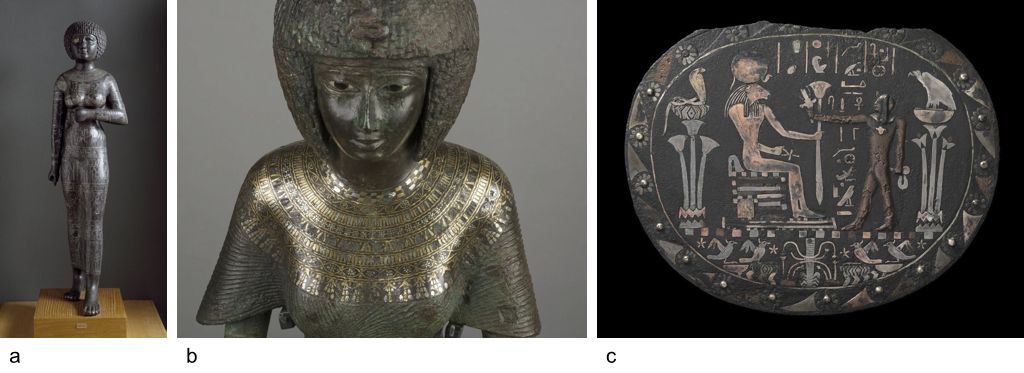
Polychrome metal inlays in Greek and Roman figural bronzes, such as those used for the eyes, lips, nipples, and even decorations of garments, have received wide scholarly attention and discussion,28 yet contemporary comparisons to the Mensa, and its particular type of inlay technique, are few. However, two inlaid bronze vessels – a pitcher and a plate – excavated in 1831 in Hungary and dated between the 3rd century BCE and the Hadrianic Period (117–138 CE), display decorative elements reminiscent of the Mensa, in particular the use of thin metal wire inlays to create Egyptianizing figures (Fig. 6a).29 More recently, similarly shaped, although undecorated, vessels have been found at the Isis sanctuary of Taposiris Magna in Egypt30 perhaps suggesting the two bronzes from Hungary might also be sacred receptacles related to the cult of Isis. To date, the closest comparison to the inlays on the Mensa is a pair of shears in the collection of the Metropolitan Museum of Art. Of unknown origin, but tentatively assigned a Roman provenance and dated to the 2nd century CE, the flat blades are decorated with polychrome metal inlays depicting Egyptian style figures and animals that bear a striking similarity to the figural depictions found on the Mensa (Fig. 6b).
a) Two inlaid vessels found in 1831 in the vicinity of the Hungarian village of Egyed. Hungarian National Museum, Budapest, HNM RT-RO 10/1951.104 (ewer), HNM RT-RO 10/1951.105 (handled dish). Photo courtesy of the Hungarian National Museum, Budapest / András Dabasi.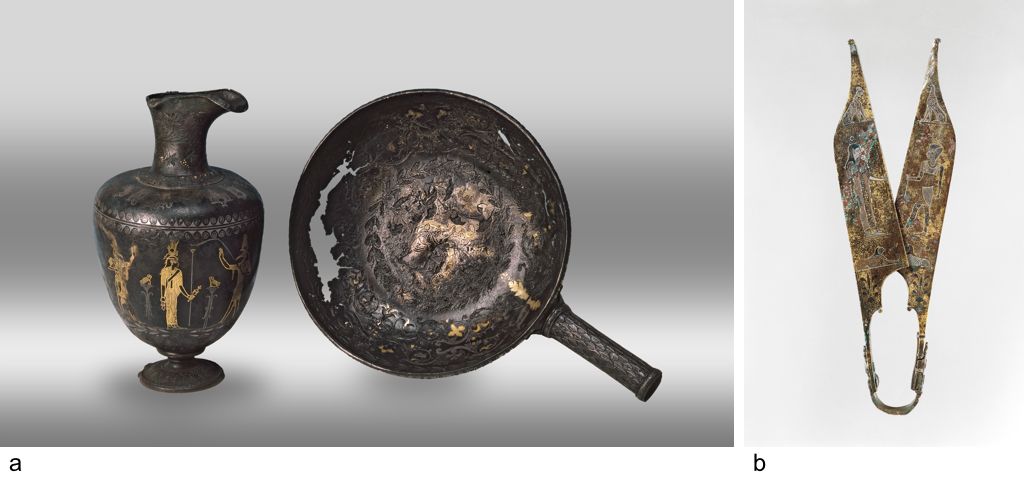
2.3 Display and function
Exactly how the Mensa was originally displayed and used remains uncertain. The sturdy frame around the edge is perforated by numerous holes on the reverse, suggesting the bronze panel was previously fastened to another support or armature (see Figs. 19, 20). Unfortunately, the underside of the Mensa does not retain any evidence from which the composition or form of such a support can be inferred (see Section 5.1 for more detailed discussion). However, based on its size, shape, and weight, it seems likely the
a) Ancient Pompeiian bronze table with horses’ legs. 1st century BCE – 1st century CE. Bronze, silver inlays, niello. Dimensions: 71.1 × 81.3 × 52.4 cm. Museo Archeologico Nazionale di Napoli. Photo courtesy of the Museo Archeologico Nazionale di Napoli.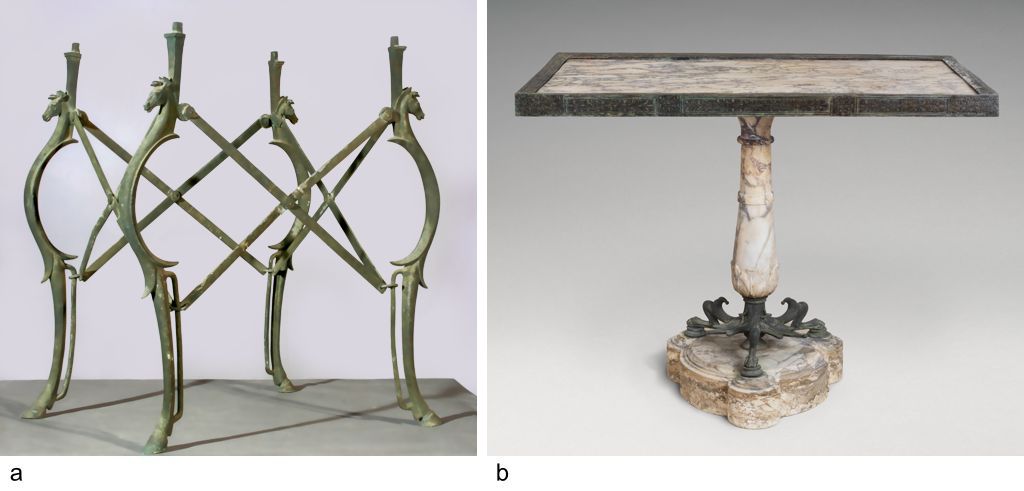
A rare textual reference to the use of metal polychromy to decorate large, flat surfaces such as the Mensa is provided by the Greek sophist Philostratus (3rd century CE) in “The Life of Apollonius” with his observations about a temple in Taxila, about which he writes:
Although we believe the Mensa was used as an altar or table, not as a wall decoration as described by Philostratus, his description of detailed figurative elements created using a golden copper alloy33 and silver, gold, and black-colored inlays in a bronze base provides evidence that such inlaid bronzes were created in ancient times, although unfortunately it appears only a few have survived to the present day.
3. Mapping the alloys of the Mensa: MA-XRF analysis
The inlays of humans, deities, animals, script, and decorative borders on the Mensa are produced from different metals and metal alloys to achieve a variety of colors and optical effects. The work by Giumlia-Mair offered first insights into the number and type of polychrome metal inlays in the Mensa: using handheld point-based X-ray fluorescence spectroscopy, she identified seven different colors (and corresponding metal alloys).34
Expanding on this work, we employed macro X-ray fluorescence (MA-XRF) scanning to generate spatially resolved maps that show the distribution, and relative intensity variation, of individual chemical elements across the entire surface of the Mensa. However, it can sometimes be more informative to view multiple maps together, digitally overlaid, so that areas consisting of multiple elements (i.e., an alloy) can be better visualized using false colors.35 With this new information, combined with visual analysis aided by microscopy, we can better assess the number of unique alloys utilized as well as gain insight into the materials and techniques employed in their creation.
3.1 Copper alloys
The individual distribution maps of copper (Cu), tin (Sn), lead (Pb), and zinc (Zn) are shown in Fig. 8. Lighter areas of the images indicate higher abundance of the element mapped, while darker areas indicate lower abundance. Copper, being the primary component of bronze, is distributed relatively uniformly across the entire surface of the base plate, and is also present throughout most, but not all, of the inlaid decorations (Fig. 8a). In the copper map, the relative brightness of the inlays compared to the base plate indicates they have a higher proportion of copper. Notably, copper was not detected (or detected at only very low levels) in a few of the metal inlays, for example the central seated figure of Isis (Leospo C-8). These copper-poor areas appear black in the copper distribution map.
MA-XRF maps of a) copper (Cu K), b) tin (Sn K), c) lead (Pb L) and d) zinc (Zn K). The brightness of each pixel is proportional to the amount of that element detected. Images produced by the authors.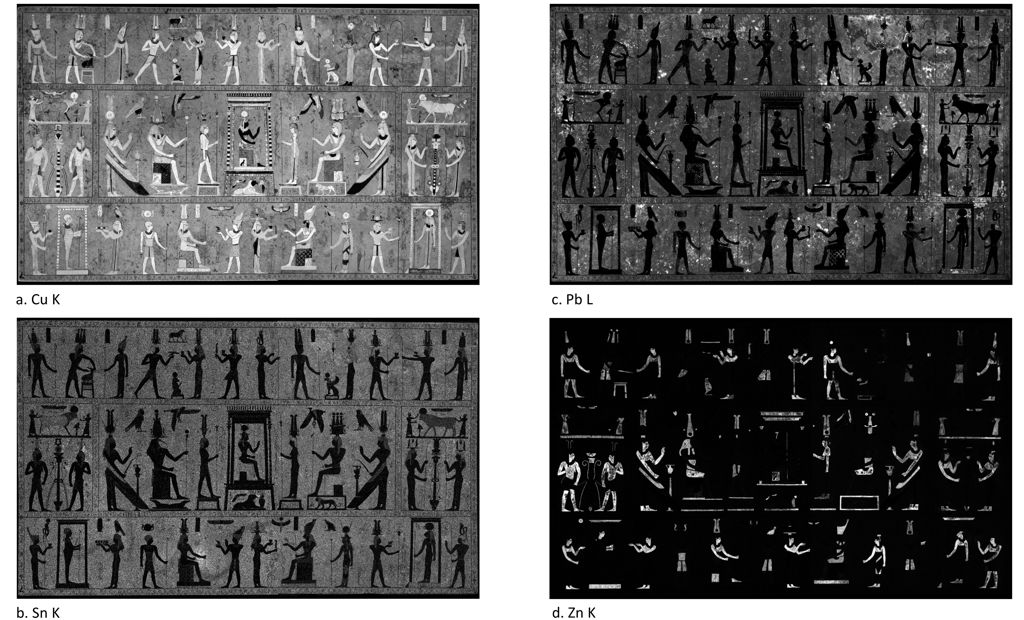
Along with copper, the other main elements in the base bronze are tin (Sn) and lead (Pb);36 their distributions across the Mensa are shown in Figs. 8b, 8c, respectively. Tin and lead are both present throughout the base plate but are absent in most of the metal inlays (small amounts are found in select inlays, as will be discussed below). While the tin distribution map appears relatively uniform across the base plate, the lead map shows noticeable inhomogeneities (bright spots indicating lead-rich areas), reflecting the fact that lead is immiscible with copper and separates out into discrete globules upon cooling.37 The distribution of zinc is provided in Fig. 8d, which shows that zinc is present in the inlays used for many of the figures as well as a subset of the decorative and architectural elements, but is seemingly absent from the base plate.
To better examine the elemental composition of the inlays, a false-color overlay of the copper, tin, and zinc maps projected into an RGB color space is presented in Fig. 9. In this rendering of the data, the pixels corresponding to the bronze base plate (a leaded copper-tin alloy, as discussed above) appear magenta due to the additive contributions of copper (in red) and tin (in blue). The inlaid figures appear either bright red, indicating high levels of copper, or bright green, indicating high levels of zinc.
RGB false color overlay of MA-XRF distribution maps of copper (red channel), tin (blue channel) and zinc (green channel). Where more than one element is present in a single pixel, the resulting color reflects the relative proportion of each element present. Image produced by the authors.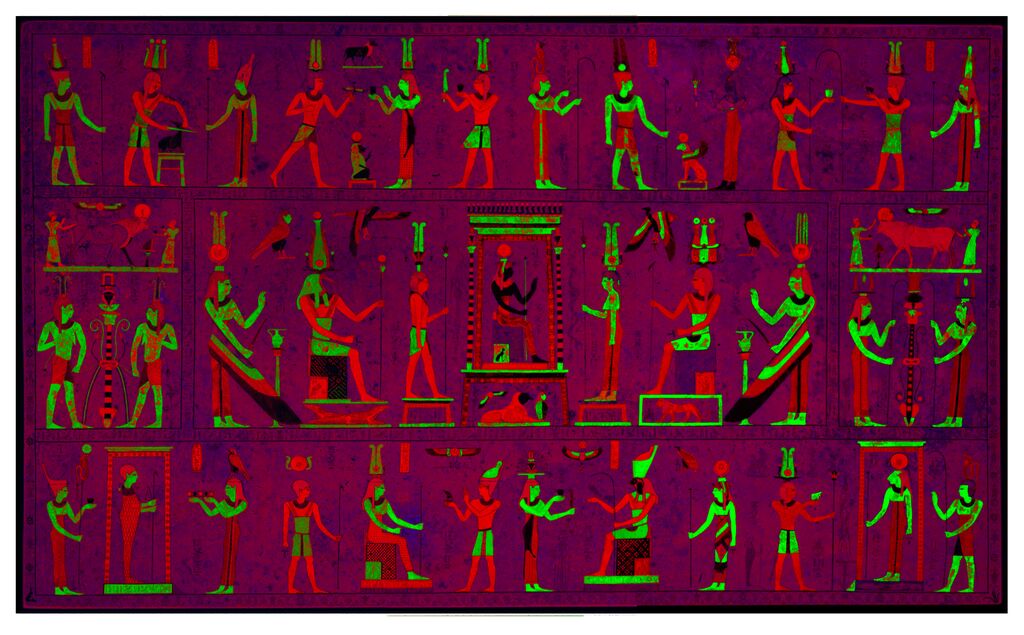
3.2 Silver and gold
Distribution maps for silver (Ag) and gold (Au) in the Mensa, presented individually and as a false color overlay, are shown in Figs. 10, 11. The silver map (Fig. 10a) is particularly striking as it most clearly reveals the integral role played by silver in the Mensa. Thin silver wires, along with pseudo-hieroglyphs and the foliate patterns, were used to delineate the five framed scenes that constitute the decorative composition. Most of the figures are outlined with silver, and silver is also found within the ornaments and clothing of many figures such as the collars, staves, dresses, and patterned kilts. Notably, Isis, at the center of the composition, is the only figure whose skin is rendered in silver.38 Because of the broad use of silver to delineate the overall design of the Mensa, the silver distribution map provides
MA-XRF maps of a) silver (Ag K), and b) gold (Au L). The brightness of each pixel is proportional to the amount of that element detected. Images produced by the authors.
The gold distribution map (Fig. 10b) reveals that the black-colored inlays – such as the wigs, headdresses, and notably, the two bulls – are copper alloys whose dominant alloying metal is gold (cf. Fig. 8a). This type of alloy, similar to modern Japanese shaku-do, is readily patinated to purplish-black tones. Referred to as
RGB false color overlay of MA-XRF distribution maps of silver (green channel), and gold (red and blue channels combined, which appears magenta). Image produced by the authors.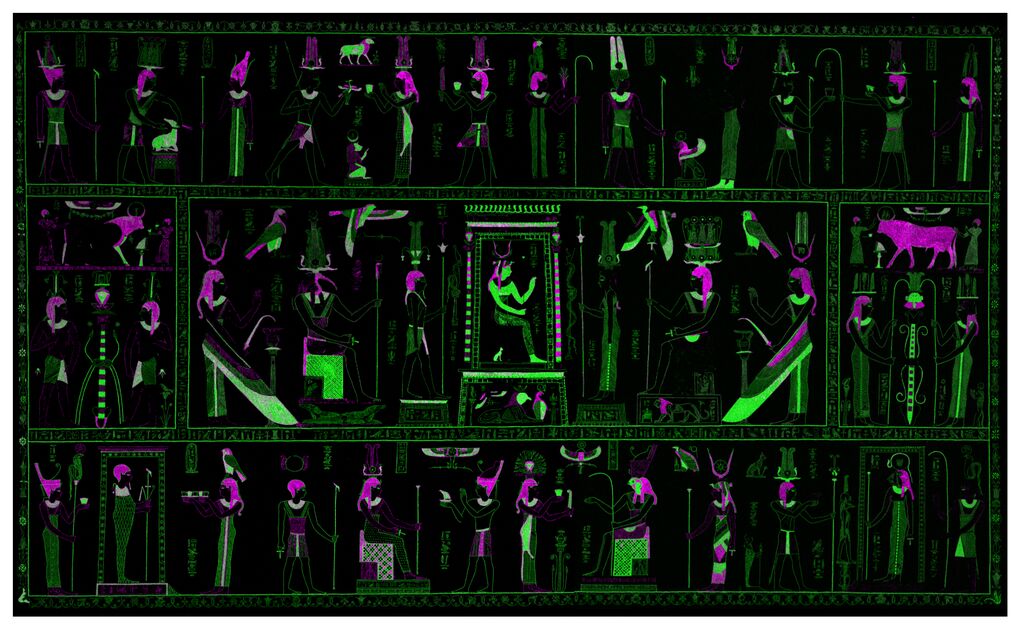
The gold distribution map also reveals that some inlays were outlined using black bronze. Just as the contrast effect described above was achieved by the use of the copper- and zinc-rich alloys found in the figures and clothing, the silver- and gold-rich alloys were used to create visual contrast in the figures and the clothing patterns. The contrast provided by the XRF map false color overlay (Fig. 11) reveals highly decorated patterns that once may have been more clearly visible.
4. The inlays
The total number of inlays on the Mensa is staggering. There are thirty-nine deities and human figures, ten freestanding animals, four animals incorporated into bases, five thrones, three shrines, and numerous other symbols (such as winged sun disks), almost all of which are made from multiple inlays. The larger figures consist of about a dozen inlay sections each, with the addition of small dots, lines, and other decorations. Silver lines forming the columns add up to several meters in length, and there are a multitude of silver hieroglyphs, as well as other silver line elements. It is estimated that, in total, there are more than a thousand individual inlaid pieces in the Mensa.
4.1 Humans, deities, and animals – large inlays
4.1.1 Copper- and zinc-rich alloys
The largest and most numerous images on the Mensa are individual human and divine figures, often depicted wearing elaborate dress and ornaments. The skin tones of these figures are monochromatic, and generally correspond to a canon whereby males are depicted in red and females in yellow. As discussed above, skin tones were created using either a copper- or zinc-rich alloy. The copper-rich alloy, which has a reddish appearance (see for example, Fig. 12a), was exclusively used for male figures and deities. The zinc-rich alloy was used for all the female figures and deities, three of the male figures (Leospo A-1, A-11, and E-18), and the two Nile gods (Leospo B-4 and B-5). The skin tones
Examples of the different skin tones found on the Mensa, created using: a) a copper-rich alloy, giving a reddish appearance (Leospo E-15), or b-d) a zinc-rich alloy providing yellow, orange, or dark brown tones, respectively (in order, Leospo A-8, B-4, C-17). Details of photo in Figure 1, courtesy of Museo Egizio.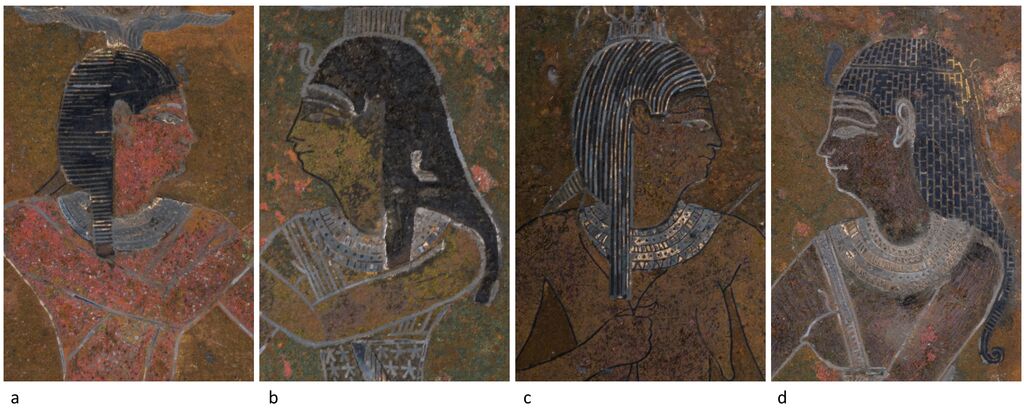
Point XRF analysis was conducted on the different skin tones to investigate whether the observed range of colors is due to a chemical difference in the metal, a differential treatment of the surface, or corrosion. The results, presented in Table 1,44 confirm the different colors observed across the zinc-rich copper alloys correspond to different alloy compositions. For example, the yellow and orange skin tones were both found to contain similar levels of zinc (around 20 wt%), but the yellow contained measurably more tin and iron.45 The dark brown skin tones, by contrast, contained less than half as much zinc as the yellow or orange, but more lead. The point measurements also confirm that the copper-rich, reddish skin tone has a measured copper content of almost 95 wt%, along with approximately 5 wt% lead, significantly different from the three zinc-rich alloys.
Elemental compositions obtained by point XRF analysis (performed with the Bruker ARTAX spectrometer) of the perceived different-colored skin tones. Experimental details provided in the Methods section.
These results support a hypothesis that specific copper alloy compositions were created to obtain different colored metal inlays. Each alloy would have responded differently to localized or overall chemical treatment, which may have been used to bring out the richly colored patinas characteristic of each metal type. Even minor variations in alloy composition can result in significantly different colors when the metal is patinated (or “pickled”).46 Although unlikely, it is also possible that the colored patinas observed on the Mensa today developed through corrosion associated with natural aging. However, based on the analyses carried out here, it is impossible to determine with certainty whether or not the inlays were intentionally patinated, and if so, by what means.
4.1.2 Silver alloy
While both copper- and zinc-rich alloys were used for humans and deities, a silver alloy (now tarnished to a grey blue) was used for the skin of Isis (Leospo C-8; Fig. 13a) and for Horus’ face (Leospo E-10; see Fig. 16b). A second female figure may also have been
Examples of the use of silver and black bronze inlays in the Mensa. a) Isis (Leospo C-8), b) baboon (Leospo A-7), and c) bull (Leospo D-2). Details of photo in Figure 1, courtesy of Museo Egizio.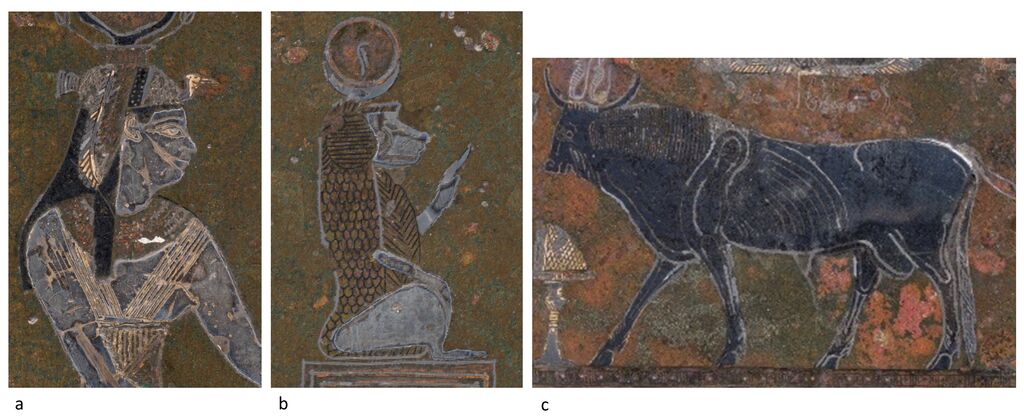
Elemental compositions obtained by point XRF analysis (performed with the Bruker ARTAX spectrometer) of the silver alloys. Experimental details provided in the Methods section.
The original appearance of the silver cannot be determined with certainty. There are several preservation states of the silver, including golden, reddish-black, black, and grey colorations. Polished silver readily tarnishes in air to form corrosion layers, typically silver sulfides, which are generally dull grey to black in color, such as that seen in the skin of Isis and the baboon shown in Fig. 13a and Fig. 13b. The golden tones, which have a specular appearance, are most easily observed in the broad collars, wings, and textiles (Fig. 14a).48 There is evidence of silver corrosion that has crept into and encroached over golden toned areas; these presumed corroded areas appear grey and exhibit irregular, blurry, edges (Fig. 14b). It is not evident, however, how much golden-toned surface might remain intact under the corrosion. One hypothesis to explain this observation is the migration and re-deposition of silver ions, a phenomenon that has been well-documented in photographic emulsions49 and is commonly observed on Japanese lacquer objects decorated with silver powder.50 Unfortunately, there is no evidence to suggest whether these golden areas survive intact from antiquity, are changes resulting from tarnish and corrosion, or are due to later restorations.
a) Detail of the winged deity (Leospo C-17) showing black bronze lines inlaid into a silver base. The silver shows a golden coloration and dark gray corrosion that in some areas has crept over the adjacent metal. Where the golden tone has been abraded, a reddish-black corrosion layer appears to be present (imaged in partially crossed polars).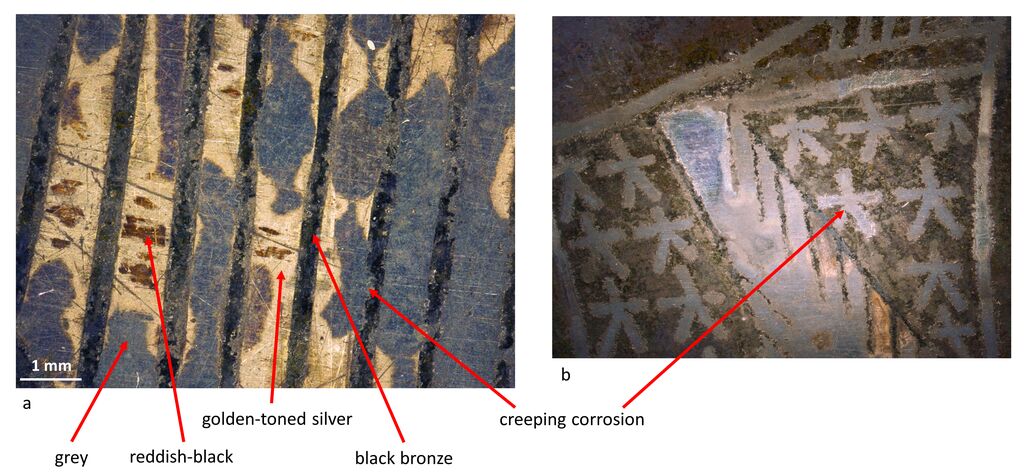
4.1.3 Black bronze
Another category of inlay metal is “black bronze”, which, as discussed above, is composed primarily of copper with gold as the most significant alloying metal.51 XRF point analysis data suggest the gold content is approximately 5 wt%, with tin present in the range of 2-3 wt% and iron, arsenic, and silver each present at around 0.5 wt%. The black bronze on the Mensa is used most extensively for the bull on the right side (Leospo D-2; Fig. 13c). Interestingly, the bull on the left side (Leospo B-2), whose inlays are now mostly missing, appears to have been inlaid with both silver and black bronze: it has a black head, but its only remaining leg (proper left front) is silver. Black bronze was also used for the wigs (see Fig. 12). Different hair styles were created by inlaying silver into the black bronze wig inlays, such as linear horizontal patterns (see Figs. 12a, 12c) and stepped vertical braid patterns (Fig. 12d); wigs are also sometimes plain with no linear decoration (Fig. 12b).
4.2 Outlines
All the figures – whether animal, human or divine – are separated from the background by black bronze or silver outlines (again, see examples in Fig. 12). This cartoon-like style is consistent with Egyptian representations in other media, such as wall paintings.52 Both types of inlaid lines are notable for being very narrow (on the order of 0.5 mm for the black, and 0.7 mm for the silver) with sharp edges.
Although we cannot be certain of their original appearance, it is clear the fine metal outlines were deliberately chosen to achieve a desired visual effect. All the black bronze inlays appear to have been outlined with silver, which, whether silver in color or patinated to a golden hue, would have created a striking contrast with the deep black. The male figures created using the copper-rich skin tone were also outlined in silver, while the figures created using the zinc-rich copper alloys have either black or silver outlines, and sometimes both. For example, the woman’s profile shown in Fig. 12b is outlined in black bronze, while her body is outlined in silver. This careful attention to detail undoubtedly was intended to make the figures stand out, creating a visually striking contrast, unfortunately now mostly lost.
4.3 Decorative patterns – small inlays
The most diverse and technically demanding category of inlays consists of multiple, small, inlaid elements to create complex patterns to decorate the thrones, borders, ornaments, garments, and wings. Representative examples of the main types of decorative patterns observed on the Mensa are discussed below.
Thrones: The throne of Isis is unfortunately missing, as is the throne of Harsomptus (Leospo C-14). The three still in place are shown in Fig. 15, along with RGB false color overlay element maps. All three thrones are constructed on a silver base into which a grid pattern has been created; alternate squares filled with two different colored alloys – one black in color and the other a copper alloy – form a pattern of nested diamonds.
The three surviving thrones on the Mensa and their corresponding RGB false color maps showing the distribution of copper (red channel), lead (green channel) and gold (blue channel; the black bronze, an alloy of gold and copper, appears magenta). a/d) Hathor’s throne (Leospo E-5), b/e) Horus’ throne (Leospo E-10), and c/f) Thoth’s throne (Leospo C-3). Details of photo in Figure 1, courtesy of Museo Egizio and XRF maps produced by the authors.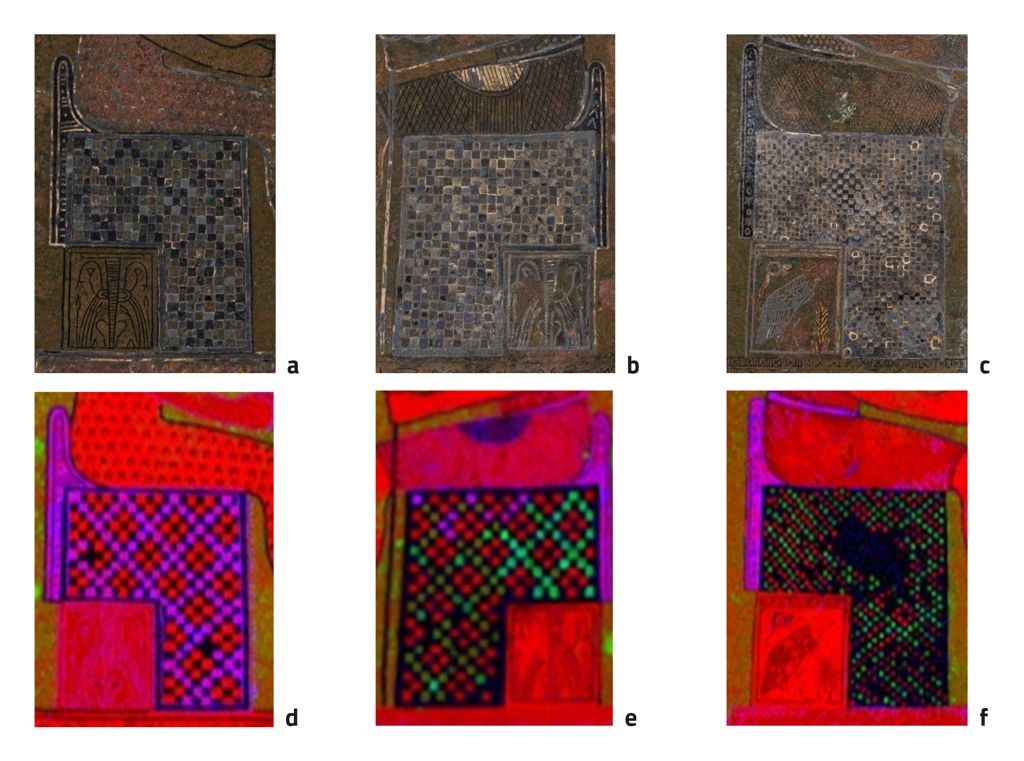
Broad collars: With the exception of Isis and Horus, all the broad collars are silver with black bronze decoration: Isis’ collar is a copper-rich alloy with silver decorations, and Horus’ collar is a zinc-rich copper alloy, decorated with black bronze (see Figs. 16a, 16b, respectively). The silver collars appear to have all been constructed using a process similar to that used for the thrones. Starting with a base inlay of silver, decorative lines, geometric bands and patterns were inlaid with black bronze (Fig. 16c). As discussed above, though much of the silver collars are now covered with creeping silver corrosion, substantial areas of some of the broad collars appear to have retained their golden tone (see Figs. 14a, 16d). It is interesting to note that when the collars are divided (for example by an arm, staff, or braid of hair), the left and right halves of the pattern are mismatched, suggesting the two halves were made separately (Fig. 16e).
Examples of the broad collars found on the human and divine figures: a) Isis (Leospo C-8), b) Horus (Leospo E-10), c-e) examples of collars showing different types of inlay work, deterioration, or inlay loss (see text). (Leospo A-5, A-11, A-14). Details of photo in Fig. 1, courtesy of Museo Egizio.
Wings and textiles: The feathered wings of birds and winged deities are depicted using alternating lines of contrasting metal alloys. The wings consist of multiple bands, each employing different combinations of colored metals and comprised of a base inlay, into which lines of the contrasting metal are inlaid. A detail of the winged female deity in the middle register (Leospo C-17) is shown in Fig. 17a. The silver in the wings is largely covered by corrosion ranging in color from grey to iridescent blue to purplish black. In some scattered areas the silver alloy bands appear golden, as described above. Similarly, some of the textiles are depicted with striped patterns while others are decorated with more vibrant geometric patterns (see example shown in Fig. 17b).
Examples of complex decorative schemes used in a) feathers (Leospo C-1) and b) textiles (Leospo A-4). In a) the upper band is black bronze decorated with silver, the next band is silver inlaid into a zinc-containing copper alloy, the next is silver inlaid into the copper-rich alloy, and the lowest band of the wing is silver decorated with black bronze. Details of photo in Fig. 1, courtesy of Museo Egizio.
4.4 Lines, borders, and hieroglyphs
There is extensive use of thin inlaid lines creating a framework for the different scenes across the Mensa. Straight lines inlaid directly into the bronze substrate are used to frame the five scenes and
a) Scene of the two Nile gods, Leospo section B, showing examples of the use of silver to create thin, straight lines to frame a scene, the pseudo-hieroglyphs contained within the frame, and a depiction of a bird perched on top of a papyrus plant is shown in the lower right corner of the scene; b) the outer edge of the scene, containing small inlaid flowers and other decorative elements; and c) extremely fine black bronze used to create a pattern in the plinth on which the bull is standing. Details of photo in Fig. 1, courtesy of Museo Egizio.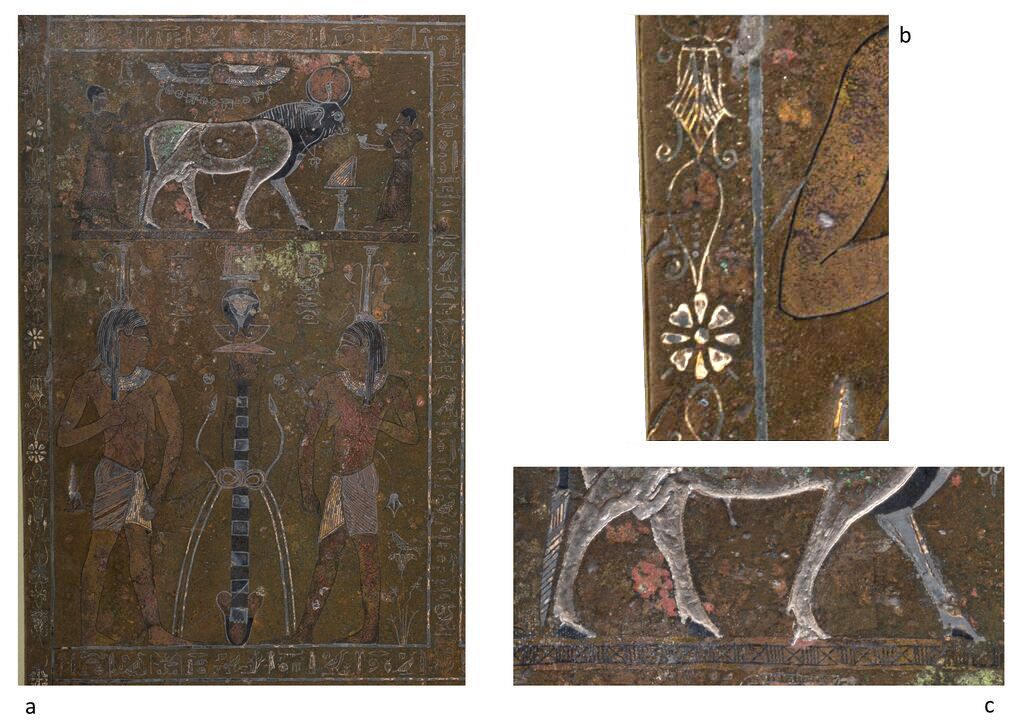
5. Creating the Mensa Isiaca
5.1 Casting the base plate
The base plate measures approximately 74 × 123 cm with edges 6 cm in depth (see Fig. 1 for precise measurements). A narrow lip on the reverse (shown in Fig. 19) that creates a U-shaped channel inside the perimeter is integral to this plate. The lip is pierced with evenly spaced and symmetrically arranged round and rectangular holes (highlighted in blue in Fig. 19) along the long edge of the plate, with the exception of one hole indicated by the red arrow in Fig. 19. There is no direct evidence to indicate when these holes were created, or whether they were added all at the same time.
Underside of the Mensa: piercings in the lip are colored blue; remnants of sprues are colored yellow. Photo courtesy of Museo Egizio, annotations by the authors.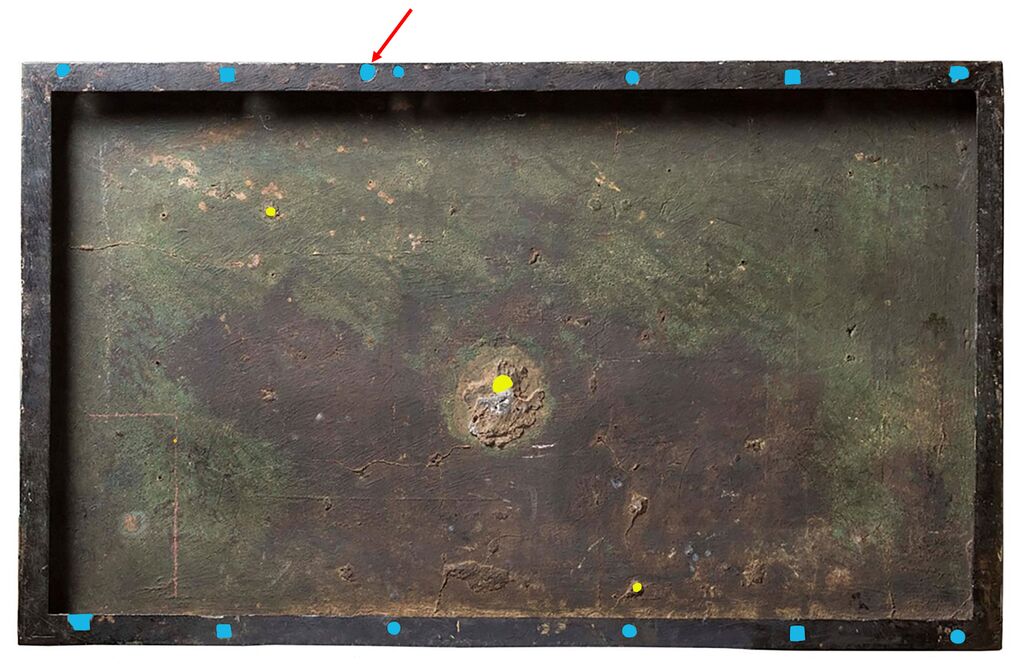
The thickness of the base plate varies considerably. This is most clearly visualized in the X-radiograph, which shows regions of higher and lower opacity (see Fig. 20). The plate appears thinnest in the center, with gradual (and variable) thickening towards the edges, with the thickest area at the bottom left (where it measures approximately 17 mm thick, compared
Digital X-radiograph of the Mensa, taken from the front side, with local contrast enhancement algorithm applied. Post-cast patches (colored red) are most concentrated in the upper left corner; core pin holes (colored yellow), some with pin residue, are evenly distributed across the surface. X-radiograph by the authors.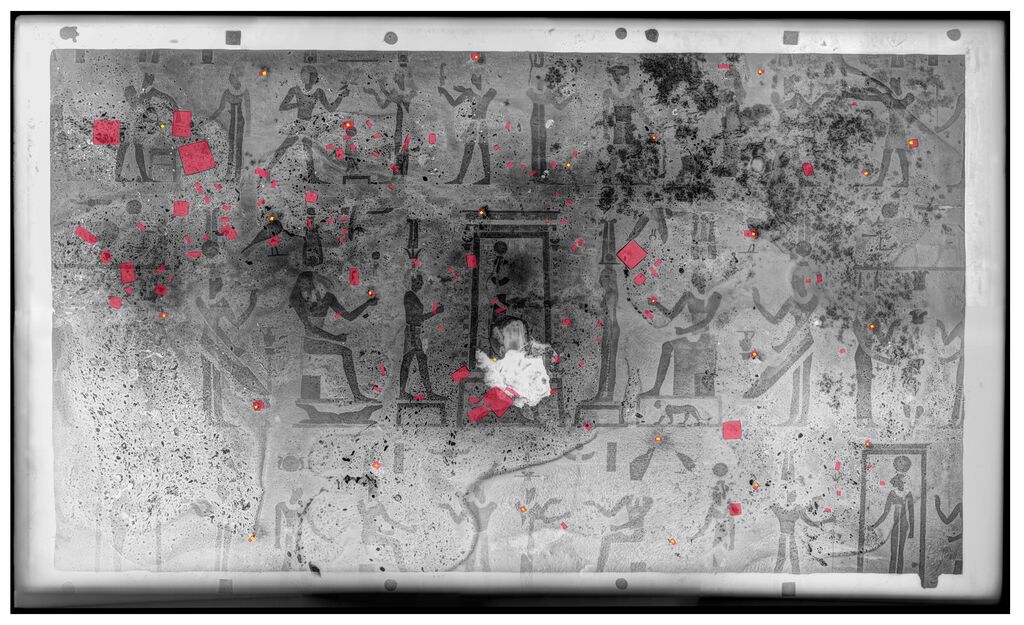
The X-radiograph also reveals pronounced heterogeneity in the base metal, with abundant porosities (seen as dark round or irregularly shaped spots) and lead globules (white spots). Some dark spots may also reflect the presence of glassy or oxidized impurities (e.g., slag and dross). Perhaps most notably, the radiograph reveals flow patterns. With curvilinear edges and distinct differences in porosity and lead distribution, these flow patterns suggest the casting was not executed in a single pour. Instead, it appears multiple crucibles containing molten metal of slightly different compositions and temperatures were used and that the metal from early pours may have begun to solidify before later pours flowed in, creating so-called “cold shuts” visible in the radiograph as curved boundary lines between more and less porous regions of metal; these are particularly noticeable in the flow at the bottom center of the radiograph. The gently curved edges of this highly porous flow suggest a viscous, lower temperature melt, flowing into an empty space and partially solidifying at the edges, while subsequent pours filled in the surrounding areas. The use of multiple crucibles is not surprising given the large quantity of metal required for the casting. It is difficult to determine the number of crucibles used, but it seems likely to have been between five and ten. Because of the inhomogeneity of the casting, point-based XRF analysis can only provide a general characterization of the overall composition of the base (see Table 1): it can best be described as a high lead tin-bronze, an alloy commonly observed in other Roman bronze objects.
Since the back surface of the Mensa was not smoothed or polished after it was formed, it contains clues as to how it may have been cast. In both the visible and X-radiographic images, a large, and perhaps the main, casting sprue can be seen just above the large white (lead) patch near the center of the plate (in yellow in Fig. 19). Two smaller bronze stubs (also in yellow in Fig. 19), which may have served as vents or sprues have also been identified, although more may have existed.54 Other evidence of the casting process includes the presence of numerous square core pin holes and remnants of original iron core pins (in yellow in Fig. 20) distributed relatively evenly over the entire plate. The presence of sprues and core pins, in addition to features observed on the underside – the absence of any detectable seams in the metal, the presence of brush marks and horizontal raised ridges, or flash lines, that continue up the edges and are interpreted as drying cracks of the clay mold (see Fig. 21) – suggest the plate was cast in one piece using the lost wax process. Given the uniqueness of the Mensa it was likely a direct cast. Lost-wax casting is regarded as the standard casting method of Greek and Roman antiquity.55 It provided fidelity in capturing fine details, and high-quality
The Mensa was likely cast face down; this would typically result in a higher quality surface since bubbles and impurities tend to rise during cooling. The numerous iron core pins would have been used to maintain a consistent separation between the upper and lower surfaces of the mold during casting. Nevertheless, the uneven thickness of the Mensa suggests the mold may have deformed and/or shifted during casting. Likewise, the core pins may have been insufficient to keep the upper part of the mold from sagging in the middle, resulting in the thinner central zone. The significantly greater thickness in the lower left quadrant may suggest the Mensa was cast at a slight angle to facilitate the flow of the metal, with the lower left corner inclined downward. The force of the molten metal charging into the mold cavity may have caused the mold to deform or crack, pushing the upper and lower surfaces apart at the lowest point, where the pressure was greatest. Casting defects such as these are common, particularly with large scale castings such as the Mensa.56
Casting evidence on the underside of the Mensa:
Porosities resulting from excess gas in the molten metal, particularly in the upper left corner, caused numerous casting defects in the surface that were repaired in antiquity with patches (in red in Fig. 20). The patches are rectangular in shape, with edges ranging in size from about 3 mm up to nearly 4 cm in length. Most these repairs are well fitted mechanically into the base plate and are barely visible to the unaided eye. Others, such as the patch behind the standing figure sacrificing a gazelle (Leospo A-2), are less well executed and even stand slightly proud of the surrounding surface (Fig. 22). The patches do not appear in the MA-XRF maps, indicating their composition is similar to the alloy of the base plate. In contrast, the patches are clearly visible in the X-radiograph as dark outlines. These dark outlines represent gaps in the metal, suggesting the beds that were chiseled out for the patches had undercut edges. It is likely slightly over-thick patches were inserted into the beds and hammered out until they were even with surface, mechanically locking into, but not entirely filling, the undercuts. The presence of patches under decorative metal inlays indicates the repairs of casting flaws and core pin holes were made prior to the insertion of the inlays, as would be expected in bronze casting practice.
Top left corner showing multiple patch repairs applied to casting flaws: a) visible image and b) X-radiograph. A badly fitted plug is visible on the left side of the image, while a group of well executed plugs are located on the right and are only visible in the X-radiograph. Detail of photo in Fig. 1, courtesy of Museo Egizio, annotation by the authors.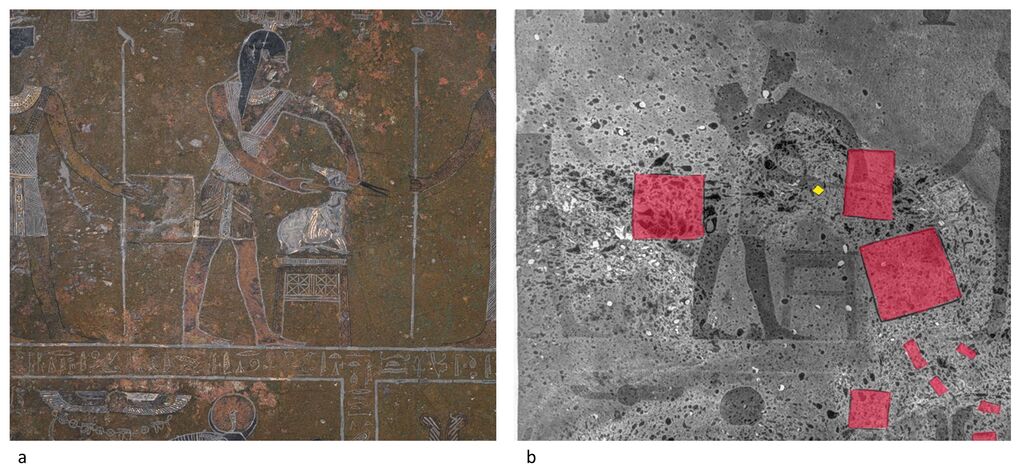
5.2 Preparation of the base plate for inlays
The creation of the complex decorative scheme would have required not only considerable artistic skill, but also a deep knowledge of the physical properties of the different pure metals and their alloys,
Figure (Leospo E-15) showing the depression of the softer copper-rich alloy with respect to the harder alloy of the base plate. a) visible and b) raking light image. Detail of photo in Fig. 1, courtesy of Museo Egizio; raking light image produced by the authors.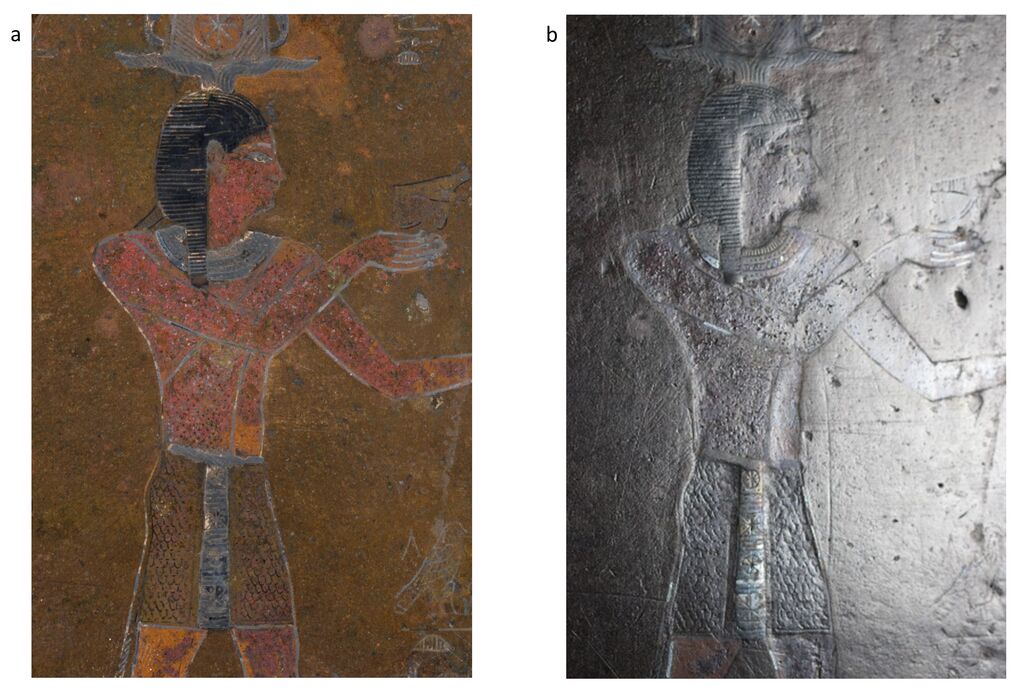
Examination of the areas where inlay has been lost reveals important clues as to how the bronze plate was prepared to receive the inlays. The areas of major inlay loss are shown in Fig. 24; losses appear to be predominantly inlays of black bronze (bull, wing, hair/wig) or silver (thrones, the queen in upper register [Leospo A-13]). The exposed surfaces of most of the recesses are irregular, with surface undulations. A few selected areas where the inlay has been lost are shown in Fig. 25. The cavity that once held Isis’ throne (Fig. 25a) was shaped to two distinct depths: a shallower recess that describes the entire shape of the throne, and a smaller, deeper rectangular recess on which Isis is seated. The final inlay assembly presumably would have been level with the front surface of the base plate. Another example is the Apis bull (Leospo B-2; Fig. 25b), which shows three different levels that held inlays: the main body and rump at two slightly different levels, separated by a ridge of bronze, and a shallower depression in a sort of saddle shape. In most cases the edges of the recesses do not appear to be undercut, or beveled. However, in the cavity for a lost wig inlay, as shown in Fig. 25c, the top edge is clearly channeled and undercut to capture the inlay. We can only speculate that this difference might have been related to the composition of the inlay (e.g. black bronze vs. copper-rich alloy) the recess was meant to receive. In keeping with standard metal working techniques, the cavities would probably have been created by mechanical means, cutting into the substrate. If any of the cavities were present in the wax model itself remains unknown. Insertion of prefabricated metal inlays, such as lips, into wax models of ancient bronze sculptures has been observed,57 but there is no evidence for such a practice on the Mensa.
Areas of inlay loss across the Mensa. Photo of the Mensa Isiaca courtesy of Museo Egizio, processed and annotated by the authors.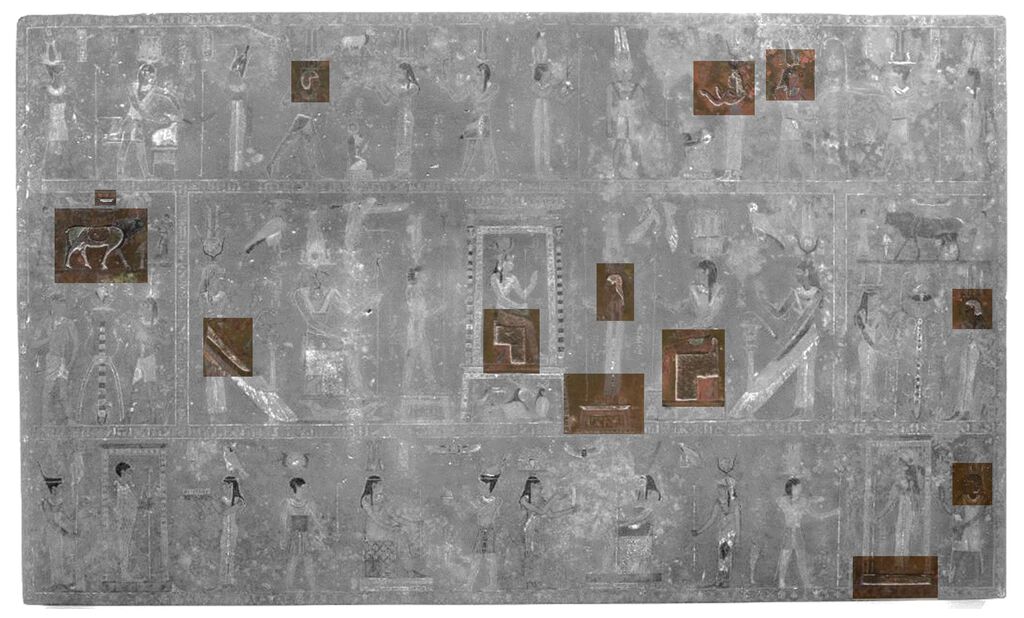
Examples of areas of inlay loss. a) Isis’ throne (Leospo C-8), showing multiple levels of preparation; b) the Apis bull (Leospo D-2); and c) recess for a hair inlay (Leospo A-5), showing undercutting to hold the inlay in place. Details of photo in Fig. 1, courtesy of Museo Egizio.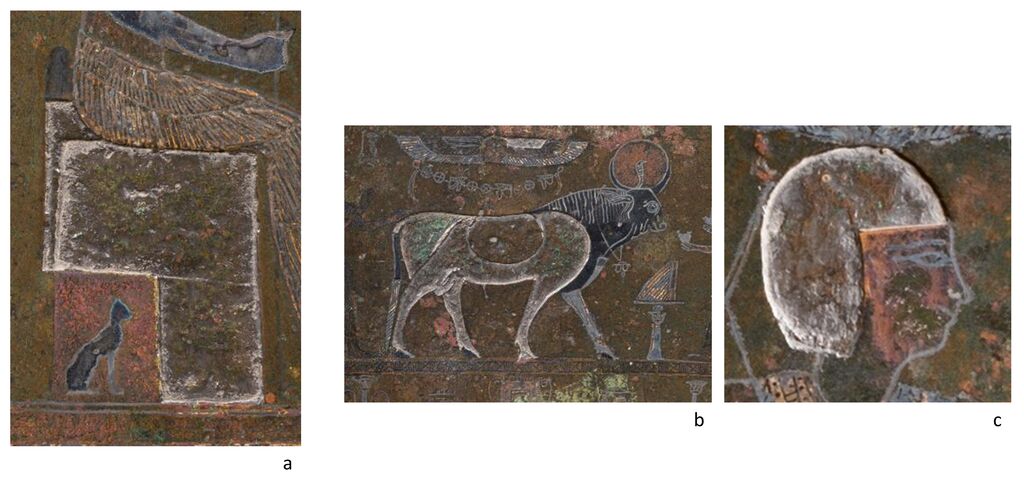
These different types of cavities may not represent the entirety of preparation for the inlays, but nonetheless point to careful planning of how individual inlays would have been secured. Given these observations, it appears that, overall, the inlays were secured by a pressure fit. All the major areas of inlay are surrounded by a thin wire of either silver or black bronze, some of which may have been applied as a means of further locking-in the press-fit inlay, resulting in a nearly seamless join.58
5.3 Patination and corrosion
The XRF analyses of the Mensa have shown that a range of alloys with different elemental compositions were deliberately selected to create the many multi-colored and ornate inlays finished in fine outlines of silver or black bronze. In addition, the use of chemical patination to provide an even broader range of colors would not be unexpected for a metal object from this period: at the time the Mensa was produced, a wide range of surface treatments, including gilding, silvering, chemical patination, niello, and enameling, were available to craftsmen allowing for the creation of different colors and design elements.59 Ancient literary sources are often difficult to interpret and do not offer accurate recipes. For example, in the Naturalis Historiae (Book XXXIII, chapter 46) Pliny states that, “the Egyptians used to stain silver used to represent their god Anubis”, and “that painting took the place of engraving”.60 Zosimos, a Greco-Egyptian alchemist active around 300 CE, provides another important literary source and describes the manipulation and patination of metal alloys, including black bronze.61 Recent analytical studies of ancient Egyptian, Greek, and Roman bronzes and metal inlays have provided evidence of intentional patination.62 Metal polychromy related to specific alloys and processes used in Asia have been explored in regard to the Mensa by Giumlia-Mair, and a recent study at the Louvre expanded related observations on a bronze from Volubilis.63 Another recent study documented the selective removal of chemical patina for decorative purposes on a Roman strigil.64 The analysis of any possible remaining patination on the Mensa was outside the scope of this study.
Typically, corrosion does not form uniformly on metals and the mottled appearance of the Mensa is not uncommon compared to other ancient bronzes.
The corrosion on the underside of the base plate is thin, dark green, compact, and well adhered. As can be seen in Fig. 26, parallel drip marks running diagonally across the underside of the base plate may suggest that at some point the plate was standing upright in an environment that allowed water to run over the surface. Despite exposure to moisture, no apparent signs of bronze disease are visible. There are no traces of pseudomorphs, which might have provided information about a former internal frame, possibly made from wood, or a now lost lining. Patches of whitish accretions, which may be traces of investment, are found in recesses on the underside (Fig. 21b).
Underside of the Mensa, showing drip marks, evidence of exposure to water. Photo by the authors.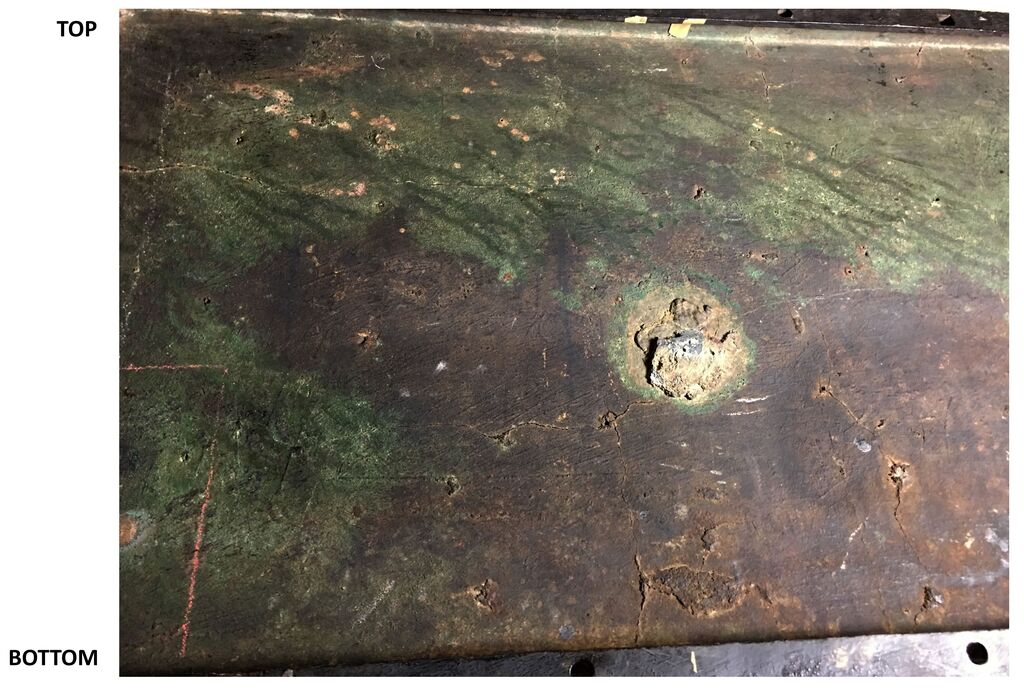
5.4 Repairs and subsequent interventions
Evidence for numerous repairs and interventions that have occurred throughout the Mensa’s long history are also present. As discussed above, interventions began immediately after casting: to repair casting flaws and core-pin holes, patches were inserted throughout the surface (see Figs. 20, 22). The large mass of lead observed in the center of the underside of the base plate remains unexplained, but it may be related to an ancient repair, or to remounting in historic times.
While many of the inlay losses were undoubtedly the result of accidental loss over the centuries, textual sources suggest that some inlays were willfully removed. Leospo illustrates two historical occurrences of vandalism. The first occurred during the sack of Mantua in 1630, when a soldier is described as having removed some of the pieces of silver.65 Presumably, this anecdote describes the forcible removal of silver metal inlays. As mentioned above, the queen in the upper register (see Fig. 27), whose face and body are now missing, was probably once silver, based on the fact that her surviving (silver) feet remain intact. Tool marks, visible at the edge of the now-missing inlays suggest the silver was pried out mechanically. A second surviving account from 1711 describes the Mensa as being “with thin silver lamina, most of which are now gone”.66 A detailed description of the damage or loss was neither recorded in 1630 nor in 1711, so it remains impossible to reconstruct what was lost, or when.
Female figure in upper register (Leospo A-13) whose (presumably) silver inlays have been pried out. Detail of photo in Fig. 1, courtesy of Museo Egizio.
Some of these damages and losses were repaired at unknown times in the object’s history. As discussed above, the three surviving thrones show evidence of multiple interventions and repairs. Evidence that at least some inlays are later replacements was provided by the MA-XRF maps: small areas throughout the surface showed elemental anomalies that diverge from the decorative scheme. As shown in Fig. 28, the presence of mercury, together with silver, copper, and iron, suggest the use of mercury amalgam gilding. While not widespread, its use in small, scattered, and isolated regions across the Mensa, most notably on the kilt of a standing male figure on the upper register (Leospo A-11), suggests a later repair. More subtle is the presence of lead-containing repairs, such as those discussed previously with respect to Thoth’s throne (see also Figs. 15c, 15f), suggesting niello was used to replace missing inlays of black bronze.
a) RGB false color overlay of MA-XRF element maps showing the distribution of mercury (blue channel), gold (red channel) and lead (green channel); b) detail of standing figure in upper register (Leospo A-11) showing mercury-containing repair. Images produced by the authors.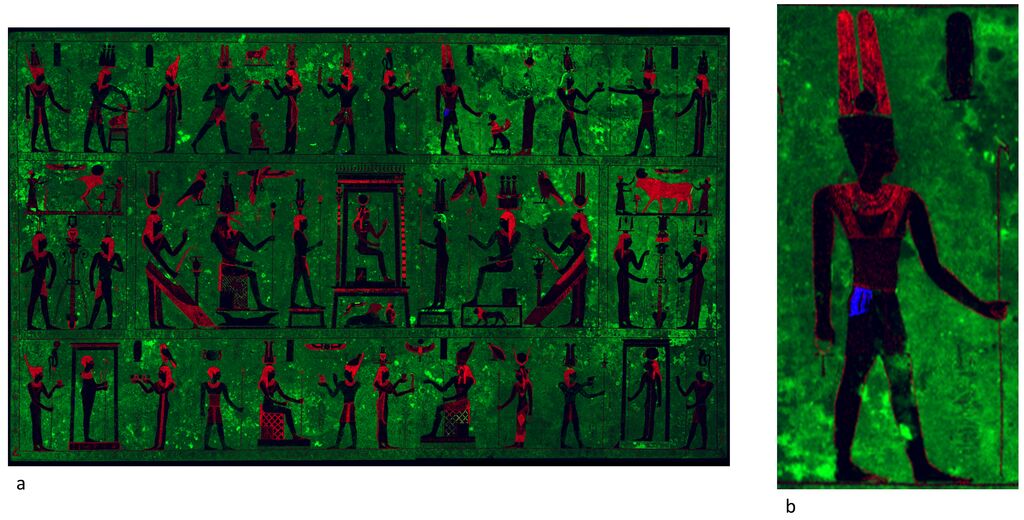
Unfortunately, most of the surface we see today is not the product and intent of the ancient craftsmen. Furthermore, the complexity of the materials paired with the object’s long history make a full accounting of how the appearance of the surface has changed over the centuries difficult to reconstruct with any certainty.
6. Conclusions and directions for further study
Based on the evidence gathered during our investigation, we propose a possible production sequence, shown in Fig. 29. In the suggested scheme, the production of the table and the inlays are described as occurring separately, in parallel, the products of which are then brought together for the insertion of the inlays followed by any final finishing processes. Briefly, the base plate, cast of a copper-tin-lead alloy, was most likely created using the direct lost wax method, with multiple pours required to fill the full expanse of the table, including the sides and lip. The majority of the figurative inlays were created using silver and at least four different copper alloys, including a copper-rich alloy for reddish skin tones, three alloys with varying amounts of zinc and tin for ranges of skin tones, and a gold-containing copper alloy (black bronze). The inlays were inserted into pre-formed cavities in the base plate (either mechanically cut, or possibly cast in the lost wax model, see above), and thin wire, either of black bronze or silver, was used to outline the inlays and secure them in place. Additional metal wire was used to create the framing lines, scripts, and other decorations. Finally, the
The different stages of construction of the Mensa. Graphic produced by the authors.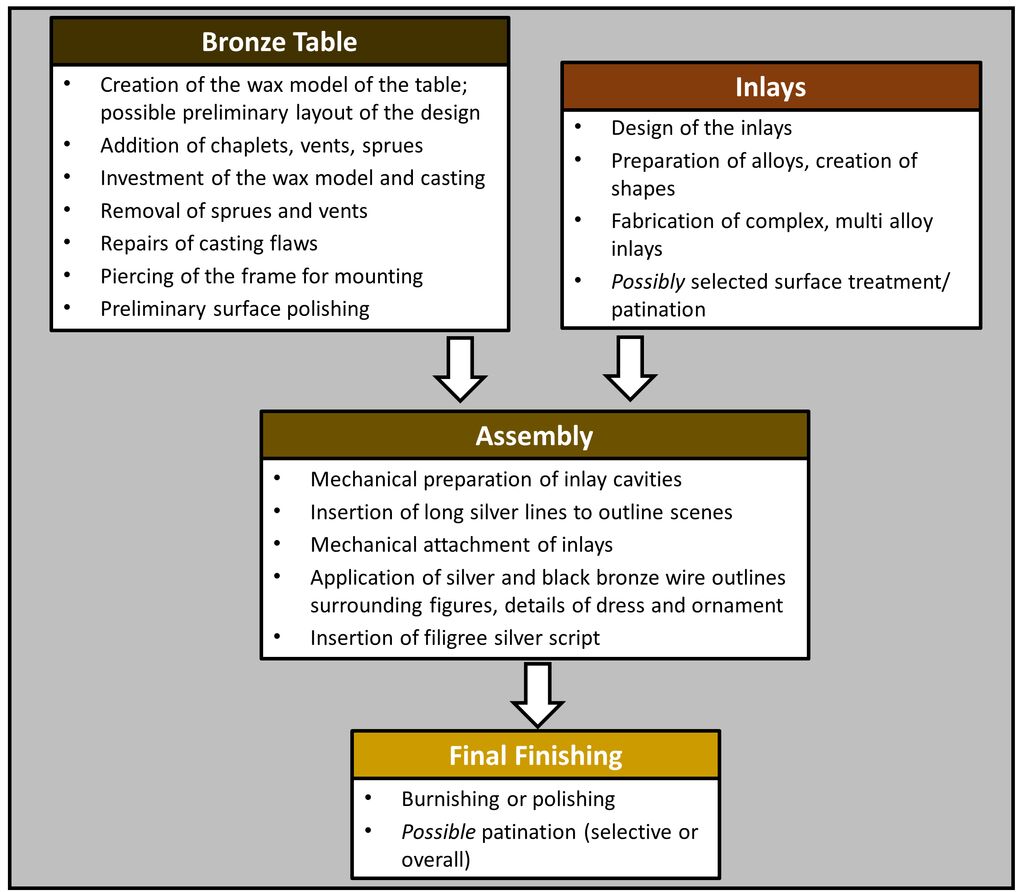
We will never know what the Mensa would have looked like when it was first created. But the data provided by the MA-XRF elemental maps have created the most accurate recording of the designs to date and have enabled new visualization of the decoration on a far more nuanced level than ever before. Using this new information, a digital model of the assumed original appearance was created (Fig. 30b). Although the color and texture assigned to the individual metal alloys remain speculative and a digital reconstruction can never adequately reflect the complex surface of the original metalwork, it nonetheless offers a glimpse of how much more striking and impactful this piece would have appeared when the inlays were more legible.
a) The central panel (Leospo C) of the Mensa. 
The new information presented here on the composition and manufacture of the Mensa Isiaca will hopefully serve as a resource for other scholars. The detailed visualization of the imagery and pseudo-hieroglyphs provided by the MA-XRF maps will enable scholars to better interpret the pictorial scheme. Furthermore, the detailed data about the composition of the individual inlays and their relationship to one another will help in further decoding the decorative protocol, for example, whether or not the material choices made by the artisans have a connection to the color canon of ancient Egypt.
Still, many questions remain unanswered and require further exploration. Analysis of remaining traces of patina may help provide a fuller picture of the range of color effects utilized across the surface. Likewise, detailed metal analysis and lead isotope studies may help to further place the materials into a larger geographic and historical framework. Ultimately, it is hoped that new interpretations in the context of art history and history of technology will be informed or initiated by this study.
7. Methods
7.1 Imaging
X-radiographs were acquired using a GE DR250UW 40 × 40 cm Direct Digital detector with 200 µm resolution. A GE Isovolt X-ray tube was operated at 300 kV and 3.0 mA with a 4.7 mm copper filter and a source to detector distance of ~ 2.5 m. A proprietary localized contrast enhancing filter was applied to the radiographs using GE Rhythm Review software. Eight individual radiographs were stitched together to produce the overall image.
Photomicrographs were acquired using a Keyence VHX-600 digital microscope using a VH-Z20R 20–200X lens equipped with a variable cross-polarizing filter set.
7.2 X-ray fluorescence spectroscopy
MA-XRF spectroscopy was performed using a Bruker M6 Jetstream spectrometer with a 30 W Rh-tube, polycapillary focusing optics and a silicon drift detector (SDD). The experiment was conducted using the following parameters: 530 μm spot size, 500 μm step size, 11 ms per-pixel dwell time. The X-ray tube was operated at 50 kV and 600 μA with a 630 μm Al primary beam filter. This resulted in count rates for the SDD detector of up to about 130 kcps. Due to its size, the scan was divided vertically into three sections partially overlapping each other to aid mosaicking. Element distribution maps were generated after calibrating and fitting the raw XRF map data using PyMca and Datamuncher.67
Additional point based XRF analyses were carried out on selected sites across the Mensa using a Bruker ARTAX spectrometer with a Cr anode X-ray tube and an SDD detector. The tube was operated at 50 kV and 600 µA. A 315 µm thick Al primary beam filter was used to block Cr characteristic radiation and the tube was fitted with a 1.5 mm diameter collimator. This configuration resulted in count rates of approximately 30 kcps for copper alloys with a dead time of approximately 8 %. The live acquisition time for each spectrum was 250 seconds.
A detailed description of the methodology used for the quantitative analysis of copper alloys has been published in several articles.68 Errors associated with the final estimates were calculated using the “error of prediction” model for the regression analysis. Lower limits of detection (designated “critical values”) associated with the calibrated results were initially calculated based on the calculated error of prediction at 95 % confidence for values close to zero. Where appropriate, error of prediction models were adjusted based upon observed heteroskedasticity in the regression model.69 For the semi-quantitative analysis of silver, the above-described methodology was modified by the use of ten standards manufactured by MBH Analytical (132X AGB 075B, 132X AGB 085B, 132X AGB 093A, 132X AGB 100B, 133X AGA1, 133X AGA2, 133X AGA3, 133X AGQ1, 133X AGQ2, and 133X AGQ3), a pure silver standard, manufactured by Premion, and three in-house silver standards, designated as GCI silver standards A, B and C.
8. Acknowledgements
This research would not have been possible without the assistance of and contributions by many individuals. We wish to express our sincere thanks to Timothy Potts (J. Paul Getty Museum) for embracing the idea of this project, and Christian Greco, Sara Aicardi, Johannes Auenmüller, Federico Poole, and Marco Rossani (Museo Egizio) for supporting the study and providing helpful insights and information throughout the project. We would like to also thank Michael Smith and Rebecca Vera-Martinez (Getty Digital, J. Paul Getty Trust) for developing the digital reconstruction; Jane Bassett, Sandy Choi Beacom, Betsy Severance, Jeffrey Spier, and Marie Svoboda (J. Paul Getty Museum) for advice and logistical support; Andrew Lacey (sculptor), Ford Hallam (metal artist), and Francesca Bewer (Harvard Art Museums) for helpful discussions about bronze casting; Yosi Pozeilov (LACMA) for creating an RTI image. Finally, thanks go to David Carson (Getty Conservation Institute) for technical assistance with scientific instrumentation and software.
9. Bibliography
Alfeld, Matthias and Koen Janssens, “Strategies for Processing Mega-pixel X-Ray Fluorescence Hyperspectral Data: A Case Study on a Version of Caravaggio’s Painting Supper at Emmaus”, Journal of Analytical Atomic Spectrometry 30.3 (2015), pp. 777–89. https://doi.org/10.1039/C4JA00387J
Aucouturier, Marc, François Mathis and Dominique Robcis, “Les bronzes noirs antiques – nouvelles observations et mécanismes de creation”, Technè. La science au service de l’histoire de l’art et de la préservation des biens culturels 45 (2017), pp. 114–23. https://doi.org/10.4000/techne.1345
Baines, John, “Color Terminology and Color Classification: Ancient Egyptian Color Terminology and Polychromy”, in: John Baines, Visual and Written Culture in Ancient Egypt, Oxford 2007, pp. 240–62.
Benzonelli, Agnese, Ian C. Freestone and Martin Martinón-Torres, “A Better Shade of Black: Effects of Manufacturing Parameters on the Development of Ancient Black Bronzes*”, Archaeometry 59.6 (2017), pp. 1034–49. https://doi.org/10.1111/arcm.12299
Bewer, Francesca, David Bourgarit, Andrew Lacey and Jean-Marie Welter, “Casting Defects”, in: David Bourgarit, Jane Bassett, Francesca Bewer, Arlen Heginbotham, Andrew Lacey and Peta Motture (eds.), Guidelines for the Technical Study of Bronze Sculpture, Los Angeles 2023, pp. 39–44.
Bonizzoni, Letizia, Anna Galli and Gianluca Poldi, “In situ EDXRF Analyses on Renaissance Plaquettes and Indoor Bronzes Patina Problems and Provenance Clues”, X‐Ray Spectrometry 37.4 (2008), pp. 388–94. https://doi.org/10.1002/xrs.1015
Boulton, Ann, Susanne Gänsicke and Shelley Sturman, “Patina”, in: David Bourgarit, Jane Bassett, Francesca Bewer, Arlen Heginbotham, Andrew Lacey and Peta Motture (eds.), Guidelines for the Technical Study of Bronze Sculpture, Los Angeles 2023, pp. 74–81.
Bradley, Mark, “The Importance of Colour on Ancient Marble Sculpture”, Art History 32.3 (2009), pp. 427–57. https://doi.org/10.1111/j.1467-8365.2009.00666.x
Bricault, Laurent, Miguel John Versluys and Paul G. P. Meyboom (eds.), Nile into Tiber: Egypt in the Roman World: Proceedings of the 3rd International Conference of Isis Studies, Leiden, May 11–14 2005 (Religions in the Graeco-Roman World 159), Leiden 2007.
Brinkmann, Vinzenz (ed.), Zurück zur Klassik – Ein neuer Blick auf das Alte Griechenland, Munich 2013.
Brinkmann, Vinzenz and Ulrike Koch-Brinkmann (eds.), Bunte Götter – Golden Edition: Die Farben der Antike, Munich 2020.
Budischovsky, Marie-Christine, “La figure de Pharaon dans la Mensa Isiaca et ses avatars italiens. Du temple pharaonique au temple isiaque”, in Valentino Gasparini and Richard Veymiers (eds.), Individuals and Materials in the Greco-Roman Cults of Isis: Agents, Images, and Practices (Religions of the Graeco-Roman World 187), Leiden 2018, pp. 322–39.
Caley, Earle Radcliffe and William B. Jensen, The Leyden and Stockholm Papyri: Greco-Egyptian Chemical Documents from the Early 4th Century AD. Cincinnati, OH, 2008.
Caponetti, Eugenio, Armetta Francesco, Delia Chillura Martino, Maria Luisa Saladino, Stefano Ridolfi, Gabriella Chirco, Mario Berrettoni, Paolo Conti, Nicolò Bruno and Sebastiano Tusa, “First Discovery of Orichalcum Ingots from the Remains of a 6th Century BC Shipwreck Near Gela (Sicily) Seabed”, Mediterranean Archaeology & Archaeometry 17.2 (2017), pp. 11–18. https://doi.org/10.5281/zenodo.581716
Cima, Maddalena and Pirzio Biroli Stefanelli, Lucia (eds.), Il Bronzo dei Romani: arredo e suppellettile, Roma 1990.
Colinart, Sylvie and Michel Menu (eds.), La couleur dans la peinture et l’émaillage de l’Égypte ancienne: actes de la table ronde, Ravello, 20-22 mars 1997, Bari 1998.
Collinet, Annabelle and Jeffrey Maish, “Inlays and Overlays”, in: David Bourgarit, Jane Bassett, Francesca Bewer, Arlen Heginbotham, Andrew Lacey and Peta Motture (eds.), Guidelines for the Technical Study of Bronze Sculpture, Los Angeles 2023, pp. 82–87.
Corzo, Miguel Angel and Mahasti Afshar (eds.), Art and Eternity: The Nefertari Wall Paintings Conservation Project 1986–1992, Santa Monica 1993.
Craddock, Paul and Alessandra Giumlia-Mair, “
Curran, Brian A. (1998). “‘De Sacrarum Litterarum Aegyptiorum Interpretatione’: Reticence and Hubris in Hieroglyphic Studies of the Renaissance: Pierio Valeriano and Annius of Viterbo”, MAAR 43/44 (1998/99), pp. 139–82.
Davies, Nina M. and Alan H. Gardiner, Ancient Egyptian Paintings, Chicago 1936.
Davies, W. Vivian (ed.), Colour and Painting in Ancient Egypt, London 2001.
De La Fuente, Amparo Arroyo, “El Cardenal Pietro Bembo y el coleccionismo de piezas egipcias en el Renacimento”, Glyphos. Revista de Historia 3 (2015), pp. 33–47.
Delange, Élisabeth, “The Complexity of Alloys: New Discoveries About Certain ‘Bronzes’ in the Louvre”, in: Marsha Hill and Deborah Schorsch (eds.), Gifts for the Gods: Images from Egyptian Temples, New Haven 2007, pp. 39–49.
Delange, Élisabeth, Marie-Emmanuelle Meyohas and Marc Aucouturier, “The Statue of Karomama: A Testimony of the Skill of Egyptian Metallurgists in Polychrome Bronze Statuary”, Journal of Cultural Heritage 6.2 (2005), pp. 99–113. https://doi.org/10.1016/j.culher.2005.01.001
Derchain, Philippe, “Über die Turiner ‘Mensa Isiaca’: Ein Deutungsversuch”, in: Günter Grimm, Heinz Heinen and Erich Winter (eds.), Das römisch-byzantinische Ägypten: Akten des internationalen Symposions 26. – 30. September 1978 in Trier, Mainz 1983, pp. 61–66.
Descamps-Lequime, Sophie, “The Color of Bronze: Polychromy and the Aesthetics of Bronze Surfaces”, in: Jens M. Daehner and Kenneth Lapatin (eds.), Power and Pathos: Bronze Sculpture of the Hellenistic World, Los Angeles 2015, pp. 151–65.
Descamps-Lequime, Sophie, “La couleur des bronzes antiques: recherches récentes”, Technè. La science au service de l’histoire de l’art et de la préservation des biens culturels 48, (2019), pp. 72–82. https://doi.org/10.4000/techne.2323
Di Pietro, Giovanni, “A Local Microscopic Model for the Formation of Silver Mirroring on Black and White Photographs”, in: John Ashton and David Hallam (eds.), Proceedings of the International Conference on Metals Conservation, Canberra 2004, pp. 126–36.
Fitzenreiter, Martin, Christian E. Loeben, Dietrich Raue und Uta Wallenstein (eds.), Gegossene Götter. Metallhandwerk und Massenproduktion im alten Ägypten, Rahden/Westf. 2014.
Fulcher, Kate, Painting Amara West: The Technology and Experience of Colour in New Kingdom Nubia (BMPAES 13), Leiden 2022.
Giehlow, Karl, Die Hieroglyphenkunde des Humanismus in der Allegorie der Renaissance, besonders der Ehrenpforte Kaisers Maximilian I. Ein Versuch, Wien 1915.
Giumlia-Mair, Alessandra, “Zosimos the Alchemist – Manuscript 6.29, Cambridge: Metallurgical Interpretation”, in Alessandra Giumlia-Mair (ed.), I bronzi antichi: Produzione e tecnologia – Atti del XV Congresso internazionale sui bronzi antichi organizzato dall’Università di Udine, sede di Gorizia, Grado-Aquilieia, 22-26 maggio 2001 (Monographies Instrumentum 21), Dremil Lafage 2002, pp. 317–23.
Giumlia-Mair, Alessandra, “Shakudo-, Sentoku-and Akagane-like Alloys in Roman-Egypt”, in: Kazuhiro Nagata, Eiji Izawa and Eiji Yamasue (eds.), Proceedings of the 8th Conference of the Beginning of the Use of Metals and Alloys (BUMA 8), Cultural Interaction and the Use of Metals, September 10-15, 2013, Nara 2014, pp. 239–44.
Giumlia-Mair, Alessandra, “Polychrome Production of a Romano-Egyptian Workshop”, in: Eckhard Deschler-Erb and Philippe Della Casa (eds.), New Research on Ancient Bronzes. Acta of the XVIIIth International Congress on Ancient Bronzes (Zurich Studies in Archaeology 10), Zurich 2015, pp. 305–10.
Giumlia-Mair, Alessandra, “Plating and Surface Treatments on Ancient Metalwork”, Advances in Archaeomaterials 1.1 (2020), pp. 1–26. https://doi.org/10.1016/j.aia.2020.10.001
Giumlia-Mair, Alessandra and Lehr, M. (1998). “Patinating Black Bronzes: Texts and Tests”, in: Anonymous (ed.), Proceedings of the Fourth International Conference on the Beginning of the Use of Metals and Alloys (BUMA IV), Matsue 1998, pp. 103–8.
Giumlia-Mair, Alessandra and Zsolt Mráv, “The Aes Corinthium Vessels from Egyed, Hungary”, Folia Archaeologica 56 (2014), pp. 73–102.
Giumlia-Mair, Alessandra and Stephen Quirke, “Black Copper in Bronze Age Egypt”, RdE 48 (1997), pp. 95–108.
Heginbotham, Arlen, Jane Bassett, David Bourgarit, Chris Eveleigh, Lisha D. Glinsman, Duncan Hook, Robert van Langh, “The Copper CHARM Set: A New Set of Certified Reference Materials for the Standardization of Quantitative X‐Ray Fluorescence Analysis of Heritage Copper Alloys”, Archaeometry 57.5 (2015), pp. 856–68. https://doi.org/10.1111/arcm.12117
Heginbotham, Arlen, David Bourgarit, Julia Day, Jan Dorscheid, Joseph J. Godla, Lynn Lee, Dominique Robcis, “CHARMed PyMca, Part II: An Evaluation of Interlaboratory Reproducibility for ED‐XRF Analysis of Copper Alloys”, Archaeometry 61.6 (2019), pp. 1333–52. https://doi.org/10.1111/arcm.12488
Heginbotham, Arlen and Vicente Armando Solé, “CHARMed PyMca, Part I: A Protocol for Improved Inter‐laboratory Reproducibility in the Quantitative ED‐XRF Analysis of Copper Alloys”, Archaeometry 59.4 (2017), pp. 714–30. https://doi.org/10.1111/arcm.12282
Hill, Marsha and Deborah Schorsch (eds.), Gifts for the Gods: Images from Egyptian Temples, New Haven 2007.
Hiorns, Arthus Horseman, Metal-Colouring and Bronzing, London 1902.
Hoffmann, Friedhelm, “Die hieroglyphischen Inschriften der Mensa Isiaca”, in Mélanie C. Flossmann-Schütze, Maren Goecke-Bauer, Friedhelm Hoffmann, Andreas Hutterer, Katrin Schlüter, Alexander Schütze und Martina Ullmann (eds.), Kleine Götter – Große Götter. Festschrift für Dieter Kessler zum 65. Geburtstag (Tuna el-Gebel 4), Vaterstetten 2013, pp. 253–64.
Hunter, Erica C. D., “Beautiful Black Bronzes: Zosimos’ Treatises in Cam. Mm. 6.29”, in: Alessandra Giumlia-Mair (ed.), I bronzi antichi: produzione e tecnologia – Atti del XV Congresso internazionale sui bronzi antichi organizzato dall’Università di Udine, sede di Gorizia, Grado-Aquilieia, 22-26 maggio 2001 (Monographies Instrumentum 21), Dremil-Lafage 2002, pp. 655–60.
Jacobson, David M. “Corinthian Bronze and the Gold of the Alchemists”, Gold Bulletin 33 (2000), pp. 60–6.
Jacobson, David M. and Michael P. Weitzman, “What Was Corinthian Bronze?”, AJA 76 (1992), pp. 237–47. https://doi.org/10.2307/505923
Knauer, Elfriede R., “Roman Wall Paintings from Boscotrecase: Three Studies in the Relationship Between Writing and Painting”, MMJ 28 (1993), pp. 13–46.
La Niece, Susan, “Niello: An Historical and Technical Survey”, The Antiquaries Journal 63.2, (1983), pp. 279–97. https://doi.org/10.1017/S000358150006652X
La Niece, Susan, Fleur Shearman, John Taylor and Antony Simpson, “Polychromy and Egyptian Bronze: New Evidence for Artificial Coloration”, Studies in Conservation 47.2 (2002), pp. 95–108.
Leospo, Enrica, La mensa isiaca di Torino (Catalogo del Museo Egizio di Torino, Serie Prima, Monumenti e Testi, Vol. 4; EPRO 70), Leiden 1978.
Lie, Henry and Carol C. Mattusch, “Introduction to the Catalogue Entries and Technical Observations,” in: Carol C. Mattusch (ed.), The Fire of Hephaistos: Large Classical Bronzes from North American Collections, Cambridge, Mass., 1996, pp. 162–78.
Luciano, Eleonora, Denise Allen, Claudia Krysa-Gersch and Stephen Campbell, Antico: The Golden Age of Renaissance Bronzes, Washington, DC, 2012.
Maish, Jeffrey, “Alloy Compositions of Select Bronze Sculptures”, in: Jens M. Daehner and Kenneth Lapatin (eds.), Power and Pathos: Bronze Sculpture of the Hellenistic World, Los Angeles 2015, pp. 311–23.
Mathis, François, Élisabeth Delange, Dominique Robcis and Marc Aucouturier, M., “HMTY-KM (Black Copper) and the Egyptian Bronzes’ Collection of the Musée du Louvre”, Journal of Cultural Heritage 10.1 (2009), pp. 63–72. https://doi.org/10.1016/j.culher.2008.03.006
Mathis, François, Sophie Descamps, Dominique Robcis and Marc Aucouturier, “Original Surface Treatment of Copper Alloy in Ancient Roman Empire: Chemical Patination on a Roman Strigil,” Surface Engineering 21.5–6 (2005), pp. 346–51. https://doi.org/10.1179/174329305X64303
Mattusch, Carol C., “The Preferred Medium: The Many Lives of Classical Bronzes”, in: Carol C. Mattusch (ed.), The Fire of Hephaistos: Large Classical Bronzes from North American Collections, Cambridge, Mass., 1996, pp. 26–28.
Murakami, Ryu, “Japanese Traditional Alloys”, in: Susan La Niece and Paul Craddock (eds.), Metal Plating and Patination: Cultural, Technical and Historical Developments, Oxford 1993, pp. 85–95.
Northover, Peter and Susan La Niece, “New Thoughts on Niello”, in Andrew J. Shortland, Ian C. Freestone and Thilo Rehren (eds.), From Mine to Microscope: Advances in the Study of Ancient Technology, Oxford 2009, pp. 145–54.
Østergaard, Jan Stubbe and Anne Marie Nielsen, Transformations: Classical Sculpture in Colour (Meddelelser fra Ny Carlsberg Glyptotek 16), Copenhagen 2014.
Parkinson, Richard, Cracking Codes: The Rosetta Stone and Decipherment, London 1999.
Pernicka, Ernst and Gerhard Eggert, “Die Zusammensetzung der Bronzeobjekte von Mahdia”, in: Gisela Hellenkemper Salies, Hans-Hoyer von Prittwitz und Gaffron and Gerhard Bauchenss (eds.), Das Wrack: Der antike Schiffsfund von Mahdia (Kataloge des Rheinischen Landesmuseums Bonn 1.1–2), Cologne 1994, pp. 1041–61.
Philostratus, The Life of Apollonius of Tyana: With an English Translation by F. C. Conybeare (Loeb Classical Library 16), London 1912.
Pliny the Elder, Natural History. Translated by H. Rackham (Vol. IX, Libri XXXIII-XXXV). (Loeb Classical Library), London 1938.
Poole, Federico (ed.), Il Nilo a Pompei: Visioni d’Egitto nel mondo romano, Modena 2016.
Poole, Federico, “Mensa Isiaca (The Bembine Tablet)”, in: Jeffrey Spier, Timothy F. Potts and Sara E. Cole (eds.), Beyond the Nile: Egypt and the Classical World, Los Angeles 2018, pp. 266–67.
Riederer, Josef, “Der Beitrag zur Metallanalyse zur Bestimmung römischer Statuettenwerkstätten”, Kölner Jahrbuch 33 (2000), pp. 575–83.
Riederer, Josef, “Die Berliner Datenbank von Metallanalysen kulturgeschichtlicher Objekte. II. Objekte aus Kupferlegierungen des 17./18. Jahrhunderts, der Renaissance und des Mittelalters”, Berliner Beiträge zur Archäometrie 17 (2000), pp. 143–216.
Rivers, Shayne and Yoshihiko Yamashita, “A Cross-Cultural Approach to Urushi Conservation: Consolidation of Metal Foil Decoration on the Mazarin Chest”, Studies in Conservation 51.sup2 (2006), pp. 286–92. https://doi.org/10.1179/sic.2006.51.Supplement-2.286
Roullet, Anne, The Egyptian and Egyptianizing Monuments of Imperial Rome (EPRO 20), Leiden 1972.
Schulze, Marie und Robert Lehmann, “Alte und neue Analyseverfahren an den Bronzen des Museum August Kestner und was sie uns verraten”, in: Martin Fitzenreiter, Christian E. Loeben, Dietrich Raue and Uta Wallenstein (eds.), Gegossene Götter. Metallhandwerk und Massenproduktion im Alten Ägypten, Rahden/Westf. 2015, pp. 133–54.
Scott, David A., Metallography and Microstructure in Ancient and Historic Metals, Los Angeles 1992.
Sickel, Lothar, “‘La più rara antiquità ch’oggi dì si trovi.’ Die Turiner ‘Mensa Isiaca’ in einem Rechtsstreit zwischen Antonio Anselmi und den Erben des Kardinals Pietro Bembo.” Pegasus. Berliner Beiträge zum Nachleben der Antike 17 (2015), pp. 109–16.
Smith, Dylan, “The Application of Alloy Analysis to Questions of Attribution: Giovanni Francesco Susini and the Workshop of Giambologna”, in: Paul Mardikian, Claudia Chemello, Christopher Watters and Peter Hull (eds.), METAL 2010 – Proceedings of the Interim Meeting of the ICOM-CC Metal Working Group, October 11-15, 2010, Charleston, South Carolina, USA, Charleston 2010, pp. 256–65.
Solé, Vicente Armando, Emmanuel Papillon, Marine Cotte, Philippe Walter and Jean Susini, “A Multiplatform Code for the Analysis of Energy-Dispersive X-Ray Fluorescence Spectra”, Spectrochimica Acta Part B: Atomic Spectroscopy 62.1 (2007), pp. 63–8. https://doi.org/10.1016/j.sab.2006.12.002
Spier, Jeffrey, Timothy F. Potts and Sara E. Cole (eds.), Beyond the Nile. Egypt and the Classical World, Los Angeles 2018.
Sternberg-El Hotabi, Heike, “Die Mensa Isiaca und die Isis-Aretalogien”, CdE 69/137 (1994), pp. 54–86.
Stone, Richard E., “Severo Calzetta da Ravenna and the Indirectly Cast Bronze”, The Burlington Magazine 148 (no. 1245) (2006), pp. 810–19.
Stone, Richard E., Raymond White and Norman Indictor, “Surface Composition of some Italian Renaissance Bronzes”, in: Kirsten Grimstad (ed.), ICOM Committee for Conservation, 9th Triennial Meeting, Dresden, German Democratic Republic, 26–31 August 1990: preprints, II, Los Angeles 1990, pp. 568–73.
Swetnam-Burland, Molly, Egypt in Italy: Visions of Egypt in Roman Imperial Culture, Cambridge 2015.
Talma, Marianna, The Application of Black-Patinated Alloys in the Eastern Mediterranean: Technology and Technology Transfer, unpublished MA-thesis Ruhr-Universität Bochum, Bochum 2015.
Vassilika, Eleni, “Mensa Isiaca. Altar Table Top”, in: David Ekserdjian (ed.), Bronze, London 2012, p. 260.
Vassilika, Eleni, “The Mensa Isiaca, an Altar for a Roman Isis Temple,” PBSR 87 (2019), pp. 349–50. https://doi.org/10.1017/S0068246219000229
Versluys, Miguel John, Aegyptiaca Romana: Nilotic Scenes and the Roman Views of Egypt (Religions in the Graeco-Roman World 144), Leiden 2002.
Vallifuoco, Maria “Oggetti in ossidiana da Stabiae: materiale e tecnica”, in: Antonella Corallini (ed.), Vesuviana. Archeologie a confronto. Atti del Convegno Internazionale (Bologna, 14–16 Gennaio 2008), Bologna 2009, pp. 485–96.
Vörös, Gyozo, Taposiris Magna: Port of Isis – Hungarian Excavations at Alexandria (1998-2001), Budapest 2001.
Wilkinson, Richard H., Symbol & Magic in Egyptian Art, London 1994.
Notes
- Museo Egizio, Turin, Cat. 7155: <a href="https://collezioni.museoegizio.it/en-GB/material/Cat_7155">https://collezioni.museoegizio.it/en-GB/material/Cat_7155</a>. Although most commonly described as a table, it has also been referred to as an altar, altar table, tablet, or tablet of Isis; for simplicity, the term table will be used throughout this paper. Poole, in Spier et al. (eds.), <i>Beyond the Nile</i>, 2018; Vassilika, <i>PBSR</i> 87 (2019); Roullet, <i>Egyptian and Egyptianizing Monuments</i>, 1972, pp. 143–44, 324, 333.↑
- De La Fuente, <i>Glyphos</i> 3 (2015); Leospo, <i>Mensa Isiaca</i>, 1978; Curran, <i>MAAR</i> 43 (1998); Sickel, <i>Pegasus. Berliner Beiträge zum Nachleben der Antike</i> 17 (2015).↑
- Parkinson, <i>Cracking Codes</i>, 1999.↑
- Giehlow, <i>Hieroglyphenkunde des Humanismus</i>, 1915, p. 182.↑
- Hoffmann, in Flossmann-Schütze et al. (eds.), <i>Kleine Götter – Große Götter</i>, 2013.↑
- Spier et al. (eds.), <i>Beyond the Nile</i>, 2018.↑
- Giumlia-Mair, in Nagata et al. (eds.), <i>8<sup>th</sup> Conference of the Beginning of the Use of Metals and Alloys</i>, 2014; Giumlia-Mair, in Deschler-Erb and Della Casa (eds.), <i>New Research on Ancient Bronzes</i>, 2015.↑
- XRF spectroscopy is a non-destructive analytical technique that measures the elemental composition of materials. It can be employed either in a single point/spot mode or in a scanning mode (macro) where thousands of individual spot measurements are combined to make a map of the elemental distribution over a larger region.↑
- Vassilika, in Ekserdjian (ed.), <i>Bronze</i>, 2012; Poole, in Spier et al. (eds.), <i>Beyond the Nile</i>, 2018, with further literature; Hoffmann, in Flossmann-Schütze et al. (eds.), <i>Kleine Götter – Große Götter</i>, 2013.↑
- The Mensa does not exhibit signs of advanced mineralization or distortion, indicating it was probably never fully buried. No major interventions are apparent, although it is highly likely that since its documented appearance in Rome in the 16<sup>th</sup> century the surface would have been cleaned, possibly polished, to enhance the legibility of the decorations.↑
- Vassilika, in Ekserdjian (ed.), <i>Bronze</i>, 2012; Poole, in Spier et al. (eds.), <i>Beyond the Nile</i>, 2018; Sternberg-El Hotabi, <i>CdE</i> 69 (1994); Derchain, in Günter et al. (eds.), <i>Das römisch-byzantinische Ägypten</i>, 1983.↑
- Leospo, <i>Mensa Isiaca</i>, 1978, pl. 30.↑
- Stenberg-El Hotabi, <i>CdE</i> 69 (1994), pp. 54–86; Budischovsky, in Gasparini et al. (ed.), <i>Individuals and Materials</i>, 2018.↑
- Vassilika, in Ekserdjian (ed.), <i>Bronze</i>, 2012. A full discussion of Renaissance casting technology and alloys is beyond the scope of this paper, although the work of Antico, which predates the appearance of the Mensa by a few decades, appears to be relevant. Antico used gold and silver surface layers to imitate metal inlays; see Luciano et al., <i>Antico: The Golden Age of Renaissance Bronzes</i>, 2012.↑
- Bonizzoni et al., <i>X‐Ray Spectrometry</i> 37 (2008); Riederer, <i>Berliner Beiträge zur Archäometrie</i> 17 (2000); Smith, in Mardikian et al. (eds.), <i>METAL 2010</i>, 2010; Stone, <i>The Burlington Magazine</i> 148 (2006); Stone et al., in Grimstad (ed.), <i>ICOM 9<sup>th</sup> Triennial Meeting</i>, 1990.↑
- Derchain, in Grimm et al. (eds.), <i>Das römisch-byzantinische Ägypten</i>, 1983, pp. 61–66.↑
- Vassilika, <i>PBSR</i> 87 (2019); Caley and Jensen, <i>The Leyden and Stockholm Papyri</i>, 2008; Giumlia-Mair, in Deschler-Erb and Della Casa (eds.), <i>New Research on Ancient Bronzes</i>, 2015.↑
- Knauer, <i>MMJ</i> 28 (1993); Poole (ed.), <i>Nilo a Pompei</i>, 2016; Swetnam-Burland, <i>Egypt in Italy</i>, 2015; Bricault et al. (eds.), <i>Nile into Tiber</i>, 2007; Versluys, <i>Aegyptiaca Romana</i>, 2002.↑
- Vallifuoco, in Coralini (ed.), <i>Vesuviana. Archeologie a confronto</i>, 2009.↑
- Bradley, <i>Art History</i> 32 (2009); Østergaard and Nielsen, <i>Transformations</i>, 2014. See also the comprehensive work by Vinzenz Brinkmann and Ulrike Koch-Brinkmann that recently included suggestions for bronzes sculptures: Brinkmann, <i>Zurück zur Klassik</i>, 2013; Brinkmann and Koch-Brinkmann, <i>Bunte Götter</i>, 2020.↑
- For a recent study of color in domestic contexts see Fulcher, <i>Painting Amara West</i>, 2022.↑
- Wilkinson, <i>Symbol & Magic</i>, 1994; Davies, <i>Colour and Painting</i>, 2001; Baines, in Baines, <i>Visual and Written Culture</i>, 2007; Colinart and Menu (eds.), <i>La couleur dans la peinture</i>, 1998.↑
- Collinet and Maish, in Bourgarit et al. (eds.), <i>Guidelines for the Technical Study</i>, 2023.↑
- Fitzenreiter et al. (eds.), <i>Gegossene Götter</i>, 2014, especially the contribution by Schulze and Lehmann.↑
- Hill and Schorsch, <i>Gifts for the Gods</i>, 2007, pp. 98–103, cat.-no. 27.↑
- Delange et al., <i>Journal of Cultural Heritage</i> 6 (2005); Delange, in Hill and Schorsch (eds.), <i>Gifts for the Gods</i>, 2007.↑
- Hill and Schorsch, <i>Gifts for the Gods</i>, 2007, pp. 104–05, cat. no. 33.↑
- Descamps-Lequime, in Daehner and Lapatin (eds.), <i>Power and Pathos</i>, 2015; Descamps-Lequime, <i>Technè</i> 48 (2019).↑
- Giumlia-Mair and Mráv, <i>Folia Archaeologica</i> 56 (2014).↑
- Vörös, <i>Taposiris Magna</i>, 2001; Giumlia-Mair and Mráv, <i>Folia Archaeologica</i> 56 (2014).↑
- Cima and Pirzio Biroli Stefanelli (eds.), <i>Il bronzo dei Romani</i> (1990), although there are other examples of bronze folding legs which may have belonged to tables. Since this publication, the table surface was removed from the bronze folding legs in Fig. 7a and they are currently without accession number (S.N.).↑
- Philostratus, <i>Life of Apollonius</i>, 1912, 2.20 and 2.22.↑
- We do not know what exact type of alloy is referred to by Philostratus, though it is likely to be a copper-zinc alloy (brass), as found in some inlays in the Mensa. For a recent discovery of copper-zinc ingots and discussion thereof, see Caponetti et al., <i>Mediterranean Archaeology & Archaeometry</i> 17 (2017).↑
- Giumlia-Mair, in Nagata et al. (eds.), <i>8<sup>th</sup> Conference of the Beginning of the Use of Metals and Alloys</i>, 2014; Giumlia-Mair, in Deschler-Erb and Della Casa (eds.), <i>New Research on Ancient Bronzes</i>, 2015.↑
- In the single-element maps presented here, the brightness of each pixel is proportional to the intensity of the corresponding XRF signal. In false-color overlays of two or more elements, each element is assigned a color in RGB (red, green, blue) space and in pixels representing locations where two or more elements are co-present, the relative contributions of each element will be reflected in the resulting color of the pixel (e.g., red + blue = magenta).↑
- This alloy composition falls into the known range of Roman copper alloys. Only a few references are provided here: Pernicka and Eggert, in Hellenkemper Salies et al. (eds.), <i>Das Wrack: Der antike Schiffsfund von Mahdia</i>, 1994; Riederer, <i>Kölner Jahrbuch</i> 33 (2000); Lie and Mattusch, in Mattusch (ed.), <i>The Fire of Hephaistos</i>, 1996; Maish, in Daehner and Lapatin (eds.), <i>Power and Pathos</i>, 2015.↑
- Scott, <i>Metallography</i>, 1992, p. 23.↑
- Another figure, now missing, was possibly also rendered in silver. See section 5.4.↑
- Craddock and Giumlia-Mair, in La Niece and Craddock (eds.), <i>Metal Plating and Patination</i>, 1993; La Niece et al., <i>Studies in Conservation</i> 47 (2002); Mathis et al., <i>Surface Engineering</i> 21 (2005); Delange et al., <i>Journal of Cultural Heritage</i> 6 (2005); Giumlia-Mair and Quirke, <i>RdE</i> 48 (1997).↑
- Pliny, <i>Natural History</i>, 1938, p. 133; Hunter, in Giumlia-Mair (ed.), <i>I bronzi antichi</i>, 2002.↑
- Benzonelli et al., <i>Archaeometry</i> 59 (2017); Giumlia-Mair, in Nagata et al. (eds.), <i>8<sup>th</sup> Conference of the Beginning of the Use of Metals and Alloys</i>, 2014; Giumlia-Mair and Lehr, in Anonymous (ed.), <i>Proceedings of the Fourth International Conference on the Beginning of the Use of Metals and Alloys</i>, 1998.↑
- Craddock and Giumlia-Mair, in La Niece and Craddock (eds.), <i>Metal Plating and Patination</i>, 1993; Mathis et al., <i>Surface Engineering</i> 21 (2005); Benzonelli et al., <i>Archaeometry</i> 59 (2017); Giumlia-Mair, <i>Advances in Archaeomaterials</i> 1 (2020); Hunter, in Giumlia-Mair (ed.), <i>I bronzi antichi</i>, 2002.↑
- Jacobson and Weitzman, <i>AJA</i> 76 (1992); Jacobson, <i>Gold Bulletin</i> 33 (2000).↑
- Results presented here were obtained using a protocol for quantitative analysis of copper alloys, details of which can be found in: Heginbotham et al., <i>Archaeometry</i> 57 (2015); Heginbotham and Solé, <i>Archaeometry</i> 59 (2017); Heginbotham et al., <i>Archaeometry</i> 61 (2019).↑
- Low levels of Sn are detectable by the point-based ARTAX XRF spectrometer, but are below the detection limit of the M6 macro-XRF spectrometer, hence its absence from the maps (see the “Methods” section for spectral acquisition details).↑
- Hiorns, <i>Metal-Colouring and Bronzing</i> (1902).↑
- Sternberg-El Hotabi, <i>CdE</i> 69 (1994).↑
- Point-based XRF analysis showed that the grey and black areas adjacent to the golden tones have a higher concentration of sulfur, supporting the hypothesis that they are the result of silver migration and corrosion. Traces of gold were detected in those silver alloys presenting a golden-toned appearance, but at insufficient amounts to account for the observed color. No other elements that might account for the golden appearance were detected. No fluorescence was observed under ultraviolet illumination, suggesting the coloration is not due to the presence of a tinted organic layer. The golden areas exhibited birefringence when viewed under reflected crossed polarized light, suggesting the presence of a crystalline material, possibly a chemical patina. Further analysis using surface-sensitive techniques such as XPS, AES, or TOF-SIMS may help elucidate the nature of the golden tones.↑
- Di Pietro, in Ashton and Hallam (eds.), <i>Proceedings of the International Conference on Metals Conservation</i>, 2004.↑
- Rivers and Yamashita, <i>Studies in Conservation</i> 51 (2006).↑
- Suitable certified reference materials are not available for this alloy, so quantitative analysis is not possible. The semi-quantitative results presented here were obtained using standardless fundamental parameters analysis (see the “Methods” section).↑
- Corzo and Afshar (eds.), <i>Art and Eternity</i>, 1993; Davies and Gardiner, <i>Ancient Egyptian Paintings</i>, 1936.↑
- Niello is a black compound containing varying amounts of sulfur, copper, silver, and/or lead, applied as a powder to engraved metals, especially silver, and melted with heat; see Northover and La Niece, in Shortland et al. (eds.), <i>From Mine to Microscope</i>, 2009; La Niece, <i>The Antiquaries Journal</i> 63 (1983).↑
- The exact process of casting the Mensa, such as the orientation and location of sprues and vents, remains unknown, and requires further study.↑
- Mattusch, in Mattusch et al. (eds.), <i>The Fire of Hephaistos</i>, 1996.↑
- Bewer et al., in Bourgarit et al. (eds.), <i>Guidelines for the Technical Study of Bronze Sculpture</i>, 2023. ↑
- Descamps-Lequime, in Daehner and Lapatin (eds.), <i>Power and Pathos</i>, 2015.↑
- In other areas of design, these wires serve a purely decorative purpose.↑
- For a general introduction to patination see Descamps-Lequime, in Daehner and Lapatin (eds.), <i>Power and Pathos</i>, 2015.↑
- “Painting” may also refer to enameling, see Pliny, <i>Natural History</i>, 1938, pp. 96–101.↑
- Giumlia-Mair, in Giumlia-Mair (ed.), <i>I bronzi antichi</i>, 2002; Hunter, in Giumlia-Mair (ed.), <i>I bronzi antichi</i>, 2002.↑
- Mathis et al., <i>Journal of Cultural Heritage</i> 10 (2009).↑
- Giumlia-Mair, in Nagata et al. (eds.), <i>8<sup>th</sup> Conference of the Beginning of the Use of Metals and Alloys</i>, 2014; Aucouturier et al., <i>Technè</i>, 2017. For Japanese alloys see Murakami, in La Niece and Craddock (eds.), <i>Metal Plating and Patination</i>, 1993.↑
- Mathis et al., <i>Surface Engineering</i> 21 (2005).↑
- Leospo, <i>Mensa Isiaca</i>, 1978, p. 21.↑
- Leospo, <i>Mensa Isiaca</i>, 1978, p. 24.↑
- Solé et al., <i>Spectrochimica Acta Part B: Atomic Spectroscopy</i> 62 (2007); Alfeld and Janssens, <i>Journal of Analytical Atomic Spectrometry</i> 30 (2015).↑
- Heginbotham et al., <i>Archaeometry</i> 57 (2015); Heginbotham and Solé, <i>Archaeometry</i> 59 (2017); Heginbotham et al., <i>Archaeometry</i> 61 (2019).↑
- Heginbotham and Solé, <i>Archaeometry</i> 59 (2017).↑










